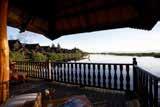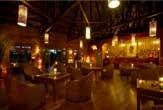






The Irrawaddy magazine has covered Myanmar, its neighbors and Southeast Asia since 1993.
EDITOR-IN-CHIEF: Aung Zaw
EDITOR (English Edition): Kyaw Zwa Moe
ASSOCIATE EDITOR: Sandy Barron
COPY DESK: Andrew D. Kaspar; David Kay; Feliz Solomon; Sean Gleeson
CONTRIBUTORS to this issue: Aung Zaw; Ye Ni; Nyein Nyein; Kyaw Hsu Mon; Lawi Weng; Kyaw Phyo Tha; Bertil Lintner; Yan Pai; Zarni Mann; San Yamin Aung; Yen Snaing; Simon Lewis; Claudia Sosa
PHOTOGRAPHERS: JPaing; Sai Zaw; Hein Htet; Teza Hlaing; Steve Tickner; Timo Jaworr
LAYOUT DESIGNER: Banjong Banriankit
SENIOR MANAGER : Win Thu (Regional Office)
MANAGER: Phyo Thu Htet (Yangon Bureau)
EMAIL: editors@irrawaddy.org
SALES&ADVERTISING: advertising@irrawaddy.org
SUBSCRIPTIONS: subscriptions@irrawaddy.org
PRINTER: Chotana Printing (Chiang Mai, Thailand)
PUBLISHER NAME : U Thaung Win
PUBLISHER LICENSE : 00706

YANGON BUREAU : Building No 170/175, Room No 806, MGW Tower, Bo Aung Kyaw Street (Middle Block), Botataung Township, Yangon, Myanmar. TEL: 01 388521, 01 389762
REGIONAL HEADQUARTERS MAILING ADDRESS: The Irrawaddy, P.O. Box 242, CMU Post Office, Chiang Mai 50200, Thailand.
54
58
12 | COVER Viewpoint: Beijing Goes Courting
14 | COVER China: Same Game, Different Tactics
Policy on Myanmar is being tweaked, not changed
20 | Politics: Mann with a Mission Union parliament speaker U Shwe Mann is growing more confident in his bid for the nation’s top job


22 |
Development: Doing Aid Better
Lahpai Seng Raw on how improvements are needed in the relationship between local and international aid partners
26 |
Development: A Step Toward Transparency
Billions of aid money is being spent in Myanmar, but where exactly is it going? A new website aims to shed some light
28 |
Education: Monk With a Vision
Sayadaw U Nayaka’s achievements on monastic schools
34 |
Politics: Peace Deal Set to Take Longer
Optimism over the immediate future of a draft nationwide ceasefire agreement appears to have been misplaced
37 |
Women: Forging the Future
Ma Nang Lai Kham of the Kanbawza group of companies


42 |
40 |
Transport: A Taxing Trip Reporter encounters nine checkpoints on 90-minute journey
Industry: Lawmakers Seek Answers on Stalled SEZ
Kyaukphyu plan is beset by delays
44 | Signposts: Insurers to Offer Health Coverage
46 |
REGIONAL
Environment: Sri Lanka’s Mangrove Protection Plan
When did you start EcoDev and what areas did you focus on at the time?
I started to engage in social welfare activities when I arrived back in Myanmar in 1994. At that time, civil society organizations had a limited role to play and we therefore had to cooperate with concerned UN agencies. We primarily helped locals claim the timber [from forests] which they had conserved from generation to generation, but that the government claimed.
After 2000, we engaged in work on the rule of law. For example, it is public knowledge that cutting down a tree is punishable by three years’ jail, although the Forestry Law does not carry that penalty. In some cases, villagers were imprisoned for cutting down a tree inside their own fence. We could help them get acquitted by appealing to the Supreme Court. Gradually, our focus has shifted from social development to the rule of law and environmental justice. We also took a lead role in protests against the Myitsone Dam. The 88 Generation Students group joined our efforts and it therefore became a massive protest movement.
Then again in 2012, we engaged in a program called “Ensuring Clean Air,” focused on handling the fumes emitted by coalfired power plants. We have been constantly engaged in campaigns against this. At present, we are working with concerned organizations
The Economically Progressive Ecosystem Development group (EcoDev) is a prominent local NGO campaigning and educating on resource rights and good environmental governance in Myanmar. Its director and co-founder, U Win Myo Thu, spoke with The Irrawaddy’s Kyaw Hsu Mon on combating deforestation and defending the rights and livelihoods of local communities in this resourcerich country.

to address environmental issues in urban Yangon. Mainly, we protect the rights of grassroots [communities]. We have labs where air and water quality can be examined and we present the results to concerned government departments and push for action.
From your experience, what environmental issues need to be addressed as a priority?
We view deforestation as the most pressing issue and the biggest threat to the environment. It is the major factor behind environmental deterioration and has many consequences. However, people tend to care more about other, more immediate problems. When we conducted a survey in over 60 townships in Kachin State and Sagaing and Tanintharyi regions, [respondents] mainly talked about water shortages and water pollution. That is very realistic because they use water every day. I had previously thought that only some areas were facing this problem of poor water quality, but then the survey suggested that it was a widespread problem and I was quite worried.
How strong is the public’s awareness of environmental issues at present?
Roughly speaking, they have [good] general knowledge about environmental conservation. They know that deforestation will lead to climate change and water scarcity. But they don’t know
about biodiversity because it is a difficult subject. It is fair to say that they have enough awareness to link causes and effects.
To what extent have forests depleted in Myanmar and what are the consequences?
According to the government’s forestry department and the Food and Agriculture Organization of the United Nations forest cover is 46 percent [of the country’s land area]. They estimate that one percent of Myanmar’s forested area is lost on average annually. This rate is very high. The government takes both dense and sparse forests into account regarding the rate of deforestation. Recently, in cooperation with a foreign university, we studied the country’s deforestation using satellite images and found that almost one percent of very thick forests in Kachin State and Sagaing and Tanintharyi regions have been lost.
Deforestation of dense forests is particularly worrying. [The government] should issue an honest statement on current deforestation rates and the remaining forest coverage. It is terrifying that the deforestation rate is one percent. It can be argued that it is the highest rate in the world. Although the current percentage of forested area is not bad compared to other countries, we can’t be satisfied with this. If this amount decreased, it would be very difficult for grassroots [communities] to sustain their livelihoods.
People may receive help during times of disaster, but help is always limited. It is the environment that helps people sustain their livelihoods. How can they survive without this? If both social capital and natural resources are depleted, people will not be able to face environmental challenges. It is important that we conserve the environment now. According to a study, there are around 20 million people living within a fivemile radius of forests and around six million people living along rivers [in Myanmar]. These people will suffer if the water and forests they rely on are depleted.
human activities. Natural causes only account for around one percent of deforestation.
Do civil society organizations like EcoDev lobby the government on combatting the illegal timber trade? What recommendations has EcoDev offered on this issue?
After studying illegal logging, there are three main factors behind it: firstly, because of greed; secondly, because of livelihood; and thirdly, because of weak bureaucratic processes… Illegal logging at the border is either directly or indirectly linked with armed groups
a [small] bunch of wood are imprisoned while those who steal logs in trucks act with impunity. The Forestry Department has difficulty in enforcing the forestry law. In some cases, they are even killed. We civil society organizations want the government to adopt national level policies on illegal logging. It needs to develop plans and organize awareness training.
Another problem is awarding licenses for seized logs. It is called License 8. [The government] imposes a fine for smuggled logs seized and then gives the logs back to smugglers officially. So they log illegally before the eyes of the public and allow themselves to get arrested. They can then take logs out of the country legally after paying the fine. [The government] does not usually give out logging licenses. These issues need to be addressed.
There are natural causes like forest fires, but mainly it is
who do so for their survival. Even if they are arrested, they may not be punished legally because of the peace process. As villagers have said, there are cases in which those who steal
So far, only export regulations for the EU market have been discussed… I want the government to draw up plans to eliminate illegal logging. While a certain proportion of logs are exported to the EU market systematically, illegal logging is still rampant in the country. It is important that people are aware. Again, the government is only focusing on exports. We want the government to focus on local use. Poor people have to use wood for their houses as well as for agricultural implements. I would like wood to be available for the poor and for priority to be given to locals. But there may be different views.
An estimated one percent of Myanmar’s forested area is lost on average annually. That rate is very high.
‘‘We do meet sometimes. When we do, he would give us necessary guidance. To tell the truth, the armed forces became modern due to his endeavors. He also put Myanmar on the path to democracy.’’

—Myanmar Army Commander-inChief Snr.-Gen. Min Aung Hlaing speaking to Japanese newspaper Mainichi about former junta supremo Snr.-Gen. Than Shwe.

So near and yet so far

‘‘We will keep moving ahead against the construction of any projects, including Dagon City, near the Shwedagon.’’
–The Society to Protect the Shwedagon, a group of monks, speaking to The Irrawaddy.
‘‘We do worry that the reforms will turn out to be a total illusion, and we think that we need more concrete steps to ensure that the democratization process is what it was meant to be.’’
–Daw Aung San Suu Kyi speakingto
the Washington Post.



be elected lawmakers; and shifting the power to appoint state and regional chief ministers from the president to regional legislatures.
Local humanitarian organizations providing aid to displaced populations in Kachin and northern Shan states said they were facing a severe funding shortage from international donor groups this year.
A constitutional amendment bill submitted to Parliament on June 10 proposes granting greater political power to regional legislatures and would reduce the threshold of votes needed to make further changes to the charter.
The bill, which required the support of at least 20 percent of lawmakers in order to go before Parliament, was published in state-run newspapers on June 11.
Its proposals include reducing, from more than 75 percent to at least 70 percent, the number of votes needed to change most parts of the Constitution; requiring that presidential candidates
The bill also suggests amending the controversial provision that bars opposition leader Daw Aung San Suu Kyi from the presidency, though she would remain ineligible for the post despite the change. The proposed amendment to Article 59(f) would remove a ban for those whose children’s spouses are foreigners, but a prohibition on having given birth to children who are foreign nationals would remain in place.
U Tun Tun Hein of the National League for Democracy (NLD) told The Irrawaddy that the proposed changes were inadequate, with the NLD having suggested amendments to 168 clauses in total. —
Nyein NyeinFive humanitarian organizations within the nine that comprise the local relief network said they have only secured US$8 million, less than 45 percent of the estimated $19 million of funding needed for 2015.
The groups have called for donors to increase financial support in order to meet urgent humanitarian needs until IDPs can safely return to their homes.
The 2015 Humanitarian Response Plan by the United Nations Office for the Coordination of
Humanitarian Affairs (OCHA) estimates that more than $71 million is needed to assist 120,000 people in need of humanitarian aid in Kachin and northern Shan States.
“Humanitarian donors globally are currently stretched and we are very concerned that the humanitarian response in Myanmar will suffer from underfunding,” Pierre Péron, spokesperson for OCHA Myanmar, told The Irrawaddy.

In Kachin and northern Shan states, Mr. Péron said, “Temporary shelters, sanitation and other facilities require renovation or replacement. Some relief items distributed early on need to be replaced.”
June 9 marked the fourth anniversary of the restart of fighting between the Kachin Independence Army and the Myanmar Army after the breakdown of a 17year ceasefire. Over 100,000 people remain displaced by the conflict. —Yen Snaing
Myanmar’s Union Election Commission (UEC) responded to claims by the National League for Democracy (NLD) that up to 80 percent of eligible voter lists compiled by the electoral body were inaccurate, with the commission chairman acknowledging numerous errors but insisting the necessary measures were in place to resolve the issue.
The NLD said in an open letter made public in June that its own
“voter list reviewing committee” had determined that between 30 percent and 80 percent of the listings were inaccurate, after scrutinizing the rosters in the 32 townships in Naypyitaw and Yangon that had been made public at the time. The errors ranged from incorrect dates of birth to the erroneous listing of people who lack identity documents, the letter said.
The UEC chairman, however, said the NLD was “exaggerating a bit.”
“From the beginning, we knew the preliminary lists would include many errors,” U Tin Aye told reporters.
“Since we were compiling the voter lists based on two outdated lists—ward-level population lists and household registration lists—the voter lists will contain many errors and thus we urged voters to check the list to correct the errors in the preliminary lists.” —San Yamin Aung
Myanmar rejected assertions that Indian armed forces entered the country in pursuit of separatists last month, saying foreign fighters would never be allowed to use Myanmar territory to stage attacks.
India’s junior minister for information and broadcasting, Rajyavardhan Singh Rathore, said India’s army attacked rebels just over the border with Myanmar on June 9, underlining New Delhi’s resolve to fight terrorism beyond the country’s borders.
However a statement from the President’s Office in Myanmar, citing information from troops in the northwest border region, said fighting had only broken out on the Indian side.
The strike was carried out in response to the killing of 20 Indian soldiers in an ambush in Manipur in

early June.
The India army said in a statement that it received intelligence that rebel forces were plotting more attacks.
The statement from the President’s Office denied that any outside forces were using Myanmar as a staging ground for attacks.
“Myanmar will never accept any foreign rebels using its territory and border area as a base,” it said. “Myanmar is willing to negotiate and cooperate with the Indian government to handle the problem.”
The statement said that India’s
ambassador to Myanmar had met with the deputy minister of foreign affairs on June 9 to “explain the situation,” but gave no further details. —Reuters
There was color, noise and passion on the streets of Yangon and throughout Myanmar in June as football fans came out in force to watch the SEA Games under-23 football final between Myanmar and Thailand.
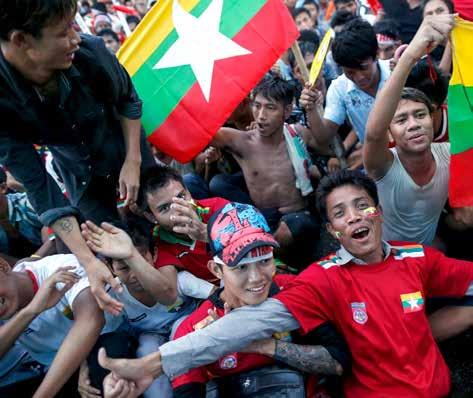
Starting out as tournament underdogs, the Myanmar team capped a stellar tournament with its first finals appearance since 2007.
In Yangon's teashops, bars and other public spaces such as Mahabandoola Park where these fans (pictured) gathered on June 15 to cheer on their team in the final, the football fever was infectious.
The heavily favored Thais ultimately wore down their spirited opponents with a 3-0 victory, leaving local fans with little choice but to look ahead with hope for the team’s next shot at the title in 2017.
PHOTO: REUTERS PHOTO: REUTERS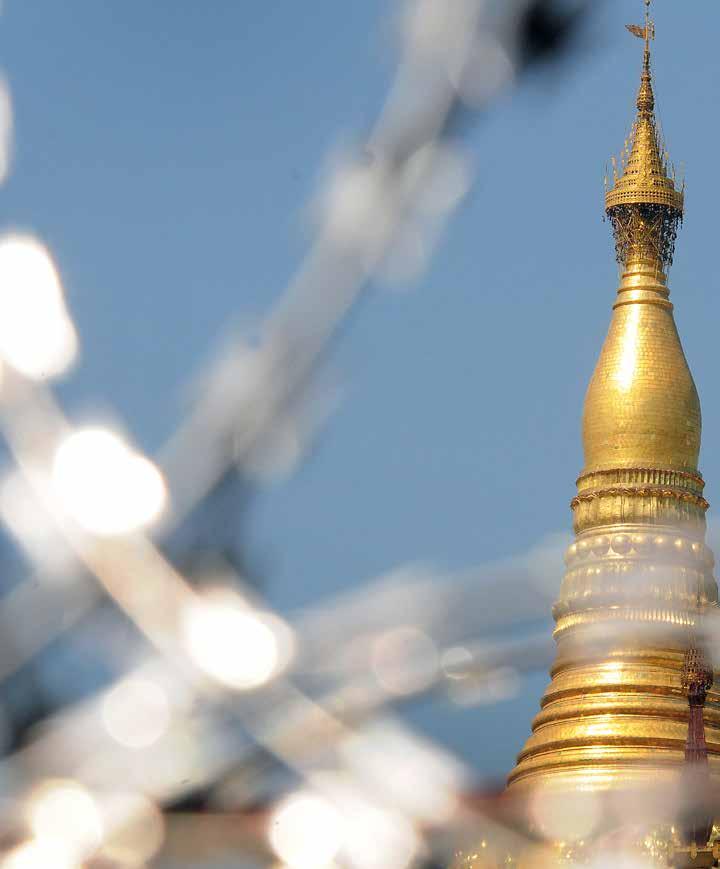
The country’s most revered Buddhist shrine is currently making headlines as civic and religious campaigners raise concerns that the pagoda’s environs would be undermined by nearby development projects.

 By AUNG ZAW
By AUNG ZAW
Beijing’s recent courting of Daw Aung San Suu Kyi was deliberate and wellcalculated. At a time when the political maneuvering in Myanmar is heating up ahead of elections later this year, “The Lady” flew to Beijing in June to meet Chinese president Xi Jinping in the Great Hall of the People. Should her visit surprise anyone?
In the minds of Chinese leaders, Daw Aung San Suu Kyi’s invitation letter was effectively penned after she made visits to the White House and other Western capitals in 2012. Beijing could not simply sit back and watch the influential opposition leader be subsumed exclusively into the Western orbit.

The government invited senior members of the National League for Democracy (NLD) to China for discussions over the last two years, laying the groundwork for last month’s high-level meeting.
On Daw Aung San Suu Kyi’s part, she sent a signal of appeasement to China in 2013 when she led a commission that green-lighted the controversial Letpadaung copper mine project despite significant local opposition.
“We have to get along with the neighboring country, whether we like
it or not,” she said amid the wave of ensuing criticism.
Once dubbed the “darling of the West,” Daw Aung San Suu Kyi recently accused the US and others of complacency on Myanmar policy. “The United States and the West in general are too optimistic and a bit of healthy skepticism would help everybody a great deal,” she said.
While the US and its allies have seemingly become more tolerant of the Myanmar government, the relationship between Naypyitaw and Beijing has soured since the 2011 suspension of the US$3.6 billion China-backed Myitsone hydropower project in northern Kachin State. Needless to say, China was not happy with the decision and has sought to have the project revived.
Tensions have also recently arisen over conflict in the Kokang Special Region along the Sino-Myanmar border which has spilled over into Yunnan, leaving several Chinese villagers dead or injured. China’s People’s Liberation Army carried out a live-fire drill along the border last month which was widely viewed as a warning to the Myanmar government.
Interestingly, the day after Daw Aung San Suu Kyi’s plane landed in Beijing, the Kokang group that has been battling the Myanmar Army
since February declared a unilateral ceasefire. Yang Houlan, China’s outgoing ambassador to Myanmar, told Snr.-Gen. Min Aung Hlaing that the Chinese government had contacted Kokang leaders to stop military operations and solve problems through political means. Was the timing a coincidence?
Despite friction, China remains Myanmar’s largest investor, accounting for about US$14.6 billion in cumulative investments—nearly a third of all FDI. The country has invested in just about every sector of Myanmar’s budding economy, with a particularly strong foothold in hydropower, gas and oil and with grand plans, such as a railway line linking Yunnan and Rakhine State, still in the offing.
China views Myanmar as crucial to securing strategic access to the Indian
Ocean. But seeing the rise of Western influence in the country once dubbed a Chinese “client state,” has given Beijing pause.
What if Western companies ramp up their investment in Myanmar, where resentment toward Chinese firms runs deep? What if US-Myanmar relations continue to improve? Chinese leaders realize the country could lose the advantage it once had when Myanmar was internationally ostracized and cut off from Western investment.
Beijing knew that inviting Daw Aung San Suu Kyi to China, with its history of support for Myanmar’s previous military junta, was complicated, but could also win the hearts and minds of many Myanmar citizens. In reaching out to the NLD leader, China was bypassing the Myanmar generals, whom it senses harbor a degree of antiChinese sentiment.
The visit also sent a signal to the West that China remains a key player
in Myanmar affairs, even as the US, the EU and others step up their engagement with the once pariah nation.
In an English-language editorial, the state-run Xinhua News Agency said Daw Aung San Suu Kyi’s visit was a sign that the Communist Party not only communicates with parties with “the same ideology, but also those with a different political vision.”
“China welcomes anyone with friendly intentions and it bears no grudge for past unpleasantness,” the editorial said.
In fact, China has been courting four potential post-election leaders in Myanmar. President Xi Jinping has separately hosted President U Thein Sein, Myanmar Army chief Snr.-Gen. Min Aung Hlaing and Union Parliament Speaker U Shwe Mann in Beijing.
Many are curious to know what the Chinese president and the Myanmar opposition leader spoke about during
their meeting in Beijing. Daw Aung San Suu Kyi has been tightlipped about the visit, telling the Washington Post only that it was “a good discussion” and that “We all understand neighbors have to live in peace and harmony.”
Many activists called on the NLD leader to speak up for imprisoned Chinese dissident, writer and fellow Nobel Peace prize winner Liu Xiaobo during her meetings in China. Sadly, this was always wishful thinking.
Like other seasoned politicians around the world, Daw Aung San Suu Kyi is guided by pragmatism; she is no longer an icon of democracy and human rights. China knows this and hence felt comfortable inviting her to Beijing.

Daw Aung San Suu Kyi’s shrewd political pragmatism may come from her father, Gen. Aung San, who led an alliance with the Japanese in order to drive out the British colonialists. He later switched sides, back to the British, in order to dislodge the Japanese. In the view of many Myanmar, Gen. Aung San is respected as a leader willing to cut a deal with either friends or enemies to achieve his goal: the nation’s independence.
Beijing may view Daw Aung San Suu Kyi as the best chance of securing its stake in the country. She is bound to be an influential political player after the elections and, if properly courted, might be willing to endorse Chinese investments and calm rising anti-China sentiment among the public.
Whether supporting China-backed development projects and large-scale investment is in the best interests of the nation is, however, an open question.
This is a new ball game, where China has decided to make a move with one eye on the November poll. The invitation to Myanmar’s opposition leader may hint that China has already placed a first bet on where political influence will lie in Myanmar’s postelection landscape.
Although it would publically state the exact opposite, for Beijing, the coming election in its troubled neighbor is much more than an “internal affair.”
China’s President Xi Jinping shakes hands with National League for Democracy leader Daw Aung San Suu Kyi during their meeting at the Great Hall of the People in Beijing, China, on June 11. By BERTIL LINTNER
By BERTIL LINTNER
 Former junta leader Snr.Gen. Than Shwe meets China’s then Communist Party Chief Hu Jintao in Beijing in January 2013.
Former junta leader Snr.Gen. Than Shwe meets China’s then Communist Party Chief Hu Jintao in Beijing in January 2013.
Much has been said and written about Daw Aung San Suu Kyi’s recent visit to China, and some commentators have even suggested that it may signal a shift in Beijing’s policy towards Myanmar— away from the government and towards a more favorable view of the prodemocracy opposition.
It would be more accurate, however, to say that China’s long-term strategic and geopolitical interests in Myanmar remain the same while its tactics vary, depending on the political climate in its troubled neighbor.
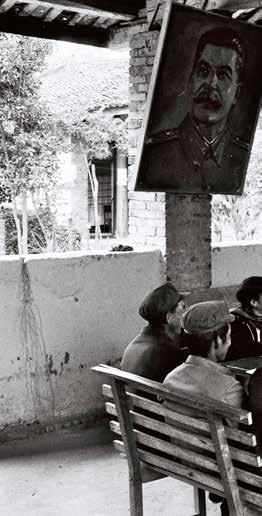
This became clear to me when, in June 2002, I had lunch with a senior adviser to Hu Jintao, the leader who later that year became Chinese president. It was a private meeting, so it would be unethical to mention his name, but I can relate the gist of our conversation without violating any trust or confidence.

I wanted to hear his opinion on my theory about Beijing’s interests in Myanmar: that China’s landlocked provinces needed an outlet for exports through Myanmar territory in order for these regions to catch up with the then-rapidly developing coastal areas.
Rail and road links to China’s own ports were too long, and those ports would in any case be clogged
with export items produced in the coastal provinces. Disparity in the development between the coast and the vast hinterland could threaten China’s national security and internal stability.
This was not a wild guess on my part. In fact, China made its intentions clear as early as 1985. In an article published in the official newsmagazine “Beijing Review” on September 2 of that year, Pan Qi, a former vice minister of communications, outlined the possibilities of finding such an outlet from Yunnan and Sichuan through Myanmar down to the Indian Ocean.
The article mentioned the Myanmar railheads of Myitkyina and Lashio in the north and northeast, and the Ayeyarwaddy River, which flows through almost the entire length of the country, as possible conduits for Chinese exports. Therefore, I surmised, China was keen to maintain the status quo in Myanmar—friendly relations with the military junta.
To my surprise, the Chinese official answered without hesitation: “Absolutely. Those are our interests in Myanmar, we do not want to see any regime change. And Myanmar is not only a potential outlet for us but also an inlet.” A strange choice of words and I asked, “an inlet for what?”
His reply startled me: “We are no longer self-sufficient in oil… Most of our imported oil comes from the Middle East, and in case of a future conflict with the United States, they can block the Straits of Malacca. Therefore, we are going to build another pipeline, through Myanmar to Yunnan.”
He didn’t specify what kind of potential conflict he was envisioning with the Americans, but it could have been an invasion of Taiwan. The United States is treaty-bound to defend Taiwan—also known as the Republic of China—but not even the most hardline hawks in the Pentagon would, in such an eventuality, consider lobbing missiles into Shanghai or Beijing.
But blocking the Straits of Malacca to cut vital oil supplies to China would be an option. And he was right about
Former Communist Party of Burma chairman Thakin Ba Thein Tin PHOTO: HSENG NOUNG LINTNERthe pipeline. In November 2008, China and Myanmar agreed to build a US$1.5 billion oil pipeline and a $1.04 billion natural gas pipeline along exactly the route this official had mentioned to me several years before.
Our conversation took place shortly after East Timor had become independent, a prospect that few could have predicted 10 years before. In the spirit of this unexpected outcome, I asked: “What would you do if Daw Aung San Suu Kyi became the president of Myanmar?” (This, of course, was before the implementation of the 2008 constitution, which bars her from assuming the presidency).
He gave me another amazing reply: “But we admire Daw Aung San Suu Kyi! We think she is a fantastic woman!” The conclusion was obvious: Beijing would
not want to see any drastic changes in Myanmar, but if they occurred, the Chinese would adjust accordingly to protect their long-term interests. And that is exactly what is happening today.
The Chinese do not want to put all their eggs in one basket. The government in Myanmar may or may not survive in its present shape and form, but the Chinese are prepared for all eventualities. This is not by any stretch of the imagination a policy shift.
With its strategic location between South and Southeast Asia, and between the Chinese hinterland and the Bay of Bengal, Myanmar has long been important to China. Forget about empty Chinese talk about “non-interference” and “respect for Myanmar’s sovereignty.” That is pure nonsense.
China has always interfered in Myanmar’s internal affairs and most probably always will. In the past it was to export world revolution; today it is trade and commerce. With a different emphasis, “the Myanmar corridor” remains of utmost importance to China’s policy makers.
During the decade 1968-78, the Chinese poured more aid into the Communist Party of Burma (CPB) than into any other communist movement outside Indochina. A new 20,000 square kilometre base area was established along the Chinese border in Myanmar’s northeast.

Unlike the old CPB units, then mainly in the Bago Yoma mountains north of Yangon, these new troops were equipped with modern Chinese assault rifles, machine-guns, anti-aircraft guns and mortars. Radio equipment, jeeps, trucks, petrol and even rice and other foodstuffs, cooking oil and kitchen utensils were sent across the frontier.
The Chinese also built two small hydroelectric power stations inside the CPB’s new northeast base. A clandestine radio station, “The People’s Voice of Burma,” began transmitting from the Yunnan side of the border in April 1971. It was later moved to the CPB’s headquarters at Panghsang inside Myanmar—now also the headquarters
A CPB meeting at Pangshang in 1987, under portraits of old Communist icons.China has always interfered in Myanmar’s internal affairs and probably always will.
of its successor, the United Wa State Army (UWSA).
Among the items China sent to the CPB was a truckload of newly printed, detailed contour maps of Myanmar. The plan was to push down from the northeast to the Bago Yoma mountain range, and eventually capture Yangon. That failed, however, as government forces launched a major offensive against the CPB in the Bago Yoma in 1975.
After the loss of other central base areas in the mid-1970s, the CPB became isolated in the northeast, far away from the Myanmar heartland, and nominated a new chairman, Thakin Ba Thein Tin, who had spent years in exile in China in the 1950s and 1960s. The area under its control was almost exclusively populated by various ethnic minorities such as the Wa, Kokang Chinese, Kachin, Akha and Lahu. Only the top leadership and most of the political commissars came from central Myanmar.
Most Western scholars have suggested that China’s post-1968 support for the CPB was prompted by anti-Chinese riots in Yangon in June 1967. But it was not a knee-jerk reaction to those events. Preparations for the push into Myanmar began shortly after the military takeover in 1962.
China had enjoyed cordial relations with the government that was overthrown, led by U Nu, and had little confidence in the new regime led by Gen. Ne Win. China also had grander plans for the entire region. It was going to export revolution to Southeast Asia, and the CPB was a vital link in that strategy. The CPB was, in turn, expected to link up with communist parties in Thailand, Malaysia, Indonesia and as far away as Australia.
The 1967 anti-Chinese riots were merely an excuse for implementing a plan that had been drawn up years before by China’s intelligence chief, Kang Sheng, a master strategist who worked closely with Thakin Ba Thein Tin and other Southeast Asian communist leaders as well as Ted Hill, the chairman of a tiny pro-Chinese communist party in Australia.
In March and April 1989, the hilltribe rank-and-file of the CPB’s
army, tired of fighting for an ideology of which they understood very little, rose in mutiny against the party’s ageing Bamar leadership. Thakin Ba Thein Tin and the other party veterans fled across the border to China, where they were allowed to settle and retire—and eventually died.
After the 1989 mutiny, the CPB broke up into four different armies, all based along ethnic lines. Of these, the UWSA was by far the most numerous and powerful. The 1989 mutiny actually suited China’s interests, and there are strong suggestions that China’s clandestine services actually encouraged the Wa and others to rise up against their Bamar bosses.
Following the death of Mao Zedong in 1976 and Deng Xiaoping’s return to the political fold, China changed its policy towards the region. Now, the emphasis was on trade and economic expansion, not Maoist-style world revolution.
The CPB’s leaders were aware of China’s new policies and in internal party documents dated before the mutiny and seen by this contributor, Thakin Ba Thein Tin
accused the Chinese of having become “revisionists.”
In a desperate last attempt to save the party, Thakin Ba Thein Tin had in early 1989 decided to send a leading cadre to Laos, a Soviet ally, to contact Moscow. That was pure lunacy since the Soviet Union was then ruled by Mikhail Gorbachev, a reformer who would have no interest whatsoever in lending support to the CPB. In any event, the mutiny broke out before the CPB emissary could reach Laos, so even he had to escape to China.
But Beijing was not going to give up the secure position it had cultivated inside Myanmar since the late 1960s. In May 1989, the UWSA entered into a ceasefire agreement with the Myanmar government, which, on the one hand, suited China’s new commercial interests. But it was also imperative to strengthen the UWSA.

As China sees it, it cannot afford to “lose” Myanmar to the West. A strong UWSA provides China with a strategic advantage and a bargaining chip.
After all, the Chinese had had a longstanding relationship with most of the leaders of the UWSA, dating back to their CPB days.
Thus, the UWSA was able to purchase vast quantities of weapons from China and, according to the April 26, 2013 issue of the prestigious military affairs journal “Jane’s Defence Weekly,” even armed transport helicopters:
“The acquisition of helicopters marks the latest step in a significant upgrade for the UWSA, which has emerged as the largest and bestequipped non-state military force in Asia and, arguably, the world,” the journal wrote.
In the second half of 2012, the UWSA had acquired armored vehicles for the first time. These included both Chinese PTL-02 6x6 wheeled “tank destroyers” and an armored combat
vehicle that IHS Jane’s identified as the Chinese 4x4 ZFB-05. Furthermore, the UWSA has obtained from China huge quantities of small-arms and ammunition—and around 100 HN-5 series man-portable air defense systems (MANPADS), a Chinese version of the first-generation Russian Strela-2 (SA-7 “Grail”) system.
The UWSA today is better armed than the CPB ever was. It can field at least 20,000 well-equipped troops apart from thousands of village militiamen and other supportive forces. Moreover, the top leaders of the UWSA are usually accompanied by Chinese intelligence officers who provide advice and guidance.
So what is China up to? Why this arming of a non-state military force at the same time as Beijing has had cordial relations with the Myanmar government since it abandoned its
policy of supporting communist insurrections in the region?
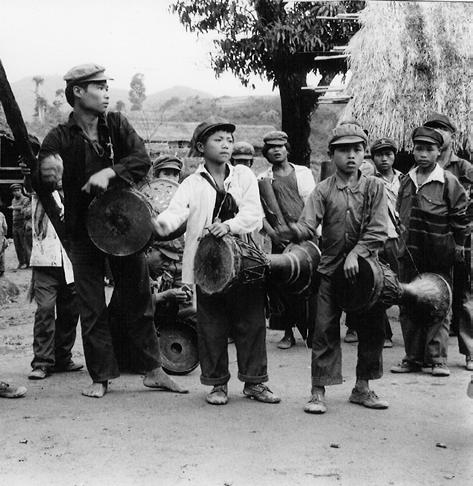
It is no doubt a way of putting pressure on Myanmar at a time when its relations with the United States are improving. As China sees it, it cannot afford to “lose” Myanmar to the West. A strong UWSA provides China with a strategic advantage and is also a bargaining chip in negotiations with Naypyitaw.
When President’s Office Minister U Aung Min visited Monywa in November 2012 to meet local people protesting a controversial Chinese-backed copper mining project, he openly admitted: “We are afraid of China… we don’t dare to have a row with [them]. If they feel annoyed with the shutdown of their projects and resume their support to the communists, the economy in border areas would backslide.”
By “the communists” he clearly meant the UWSA and its allies, among them the Myanmar National Democratic Army (MNDAA) in Kokang, another former CPB force, which resorted to armed struggle in February this year. China, predictably, has denied any involvement in that conflict, but the fact remains that most of the MNDAA’s weaponry and vast quantities of ammunition have been supplied by the UWSA.
According to one well-placed source, China is indirectly “teaching the Myanmar government a lesson in Kokang: move too much to the West, and this can happen.” At the same time, China is playing another “softer” card by being actively involved in so-called “peace talks” between the Myanmar government and the country’s multitude of ethnic rebel armies.
Whether China wants to export revolution or expand and protect commercial interests, it apparently feels that it needs to have a solid foothold inside Myanmar. There is no better and more loyal ally in this regard than the UWSA and its affiliates.
Inviting Daw Aung San Suu Kyi to China essentially serves the same purpose: to put pressure on the government in Naypyitaw and keep its options open for the future—all with the aim of securing the vital “Myanmar corridor.”
With Myanmar’s national elections less than six months away, the million dollar question is: who will be the next leader of the country?
At the fourth central committee meeting of the Union Solidarity and Development Party (USDP) held in Naypyitaw in May, it was announced that Union Parliament speaker U Shwe Mann would remain at the helm as chairman, leading the party into the elections slated for November.
It seems that U Shwe Mann, who has openly declared his interest in the presidency, has grown in confidence after visits to the US and China in April. What strategies will the third most powerful general of the former regime employ in his bid for the presidency? We will have to wait and see.
The political intentions of incumbent president U Thein Sein remain a mystery. Although he has not stated whether he would seek a second term, in his monthly radio address in May, in reference to the peace process, the president said his administration intended to leave a strong foundation for the next government to build upon.
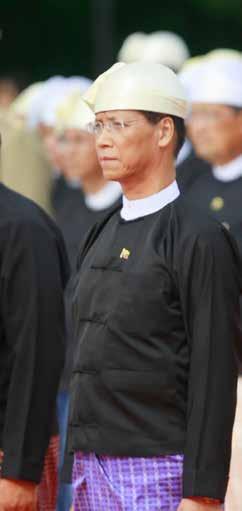
Does this imply he won’t run for reelection? If so, it could signal an end to the internal tug of war between the president and the parliamentary speaker, paving the way for the latter to run for the country’s top job.
But the road to the presidency is far from straightforward for U Shwe Mann, with the majority of political pundits predicting that the USDP is heading for
a humiliating defeat if the forthcoming elections are free and fair.
The forerunner of the USDP, the Union Solidarity and Development Association (USDA), was founded in 1993 on the instructions of former Snr.-Gen. Than Shwe. The USDA engaged in activities suppressing the pro-democracy movement of which Daw Aung San Suu Kyi was the most recognizable face since 1988.
In 1997, she branded USDA members thugs. Six years later, her motorcade was attacked by a pro-junta armed group, including members of the USDA and hired heavies from Swan Arshin, at Depayin in Sagaing Region.
The reputation of the USDA went from bad to worse when its members were again implicated in the regime’s violent crackdown on Saffron Revolution protesters in 2007. The organization then transformed itself into a political party—the USDP—in 2010 to contest that year’s general elections.
After the country’s main opposition party, the National League for Democracy (NLD), boycotted the polls, the USDP won in a landslide—a result discredited by reports of widespread electoral irregularities.
Despite some important reforms, the ruling USDP and the quasi-civilian executive have protected the common interests of the army and their cronies while students, activists, farmers and workers continue to be imprisoned
simply for peacefully expressing dissent.
But even with a tainted image, the USDP does retain some electoral advantages. The party is financially strong and its network stretches across the country. It is familiar with the bureaucracy and can lay claim to a degree of “experience” in governance, in contrast to the NLD.
However, whether this translates to a U Shwe Mann-presidency depends greatly on opposition leader Daw Aung San Suu Kyi.
U Shwe Mann maintained a healthy political relationship with Daw Aung San Suu Kyi throughout 2014 and has been smoothing the way for an unlikely coalition between the two major parties. During his recent visit to the US, the parliamentary speaker said he was willing to cooperate with the NLD leader.
Under Article 59(f) of the 2008 Constitution, Daw Aung San Suu Kyi is barred from the presidency, even if the
Union
marking the anniversary of Martyrs’ Day at the Martyrs’ Mausoleum in Yangon last year.
persuade the NLD or many ethnic political parties in regions subject to decades of human rights abuses at the hands of the Myanmar Army.
Could he win the backing of the USDP?
The once-accepted unity between the USDP and the military is on the wane. The USDP under U Shwe Mann appears to be edging away from the army and is transforming itself into a more independent political party. It no longer wishes to be identified as a party stacked with generals-turned-MPs.
“We won’t just field army men,” said USDP General Secretary U Thein Swe at a press conference on May 31. “We’ll field those who have the potential for victory in [constituencies] where we can win. It is up to us whether or not to accept [candidates], no matter how many the army sends us.”
NLD wins the elections. On this highly contentious issue, U Shwe Mann has sent mixed messages.
In 2014, he said the charter should be amended to allow the NLD leader to run for the country’s highest office. However, he has since spoken of the impossibility of amending the constitution before the election.
For her part, Daw Aung San Suu Kyi refused to rule out boycotting the elections in an apparent attempt to pressure the government on constitutional change. However, this would seem an unlikely move given the opposition leader would still wield significant influence in the legislative chamber if the NLD claimed an expected electoral majority.
If so, Daw Aung San Suu Kyi may be willing to countenance a U Shwe Mann presidency.
While detractors may view her support of a former general as disloyal to supporters of the NLD and the broader democracy movement, others could see such a compromise as paving the way for constitutional change at a later date, including Article 59(f).
Myanmar Army chief, Snr.-Gen. Min Aung Hlaing, has urged for loyalty to the 2008 Constitution in its current form. This is a solid indication that the military will not easily relinquish its formidable political role.
The Defense, Home Affairs and Border Affairs ministers are all army appointees and 25 percent of parliamentary seats are reserved for the military.
Snr.-Gen. Min Aung Hlaing, who is said to be a confidante of Snr.-Gen. Than Shwe, is due to retire soon and rumors have swirled that he may throw his hat in the ring for the country’s presidency.

If so, he would likely enjoy the backing of those military representatives constitutionally enshrined in the new post-elections parliament. However, these votes alone would not be enough. He would also need the support of other lawmakers, including from ethnic political parties.
Before the election, the commanderin-chief may need to form a political alliance. It is doubtful that he could
While the USDP may profess to keep its distance from the military, its leadership, ex-generals themselves, understands the army’s concerns and will be careful to manage any tensions.
On a recent visit to meet wounded Myanmar Army soldiers in a military hospital in Shan State’s Lashio, U Shwe Mann threw his support behind the army, describing their fight against Kokang rebels as “a fight for justice.”
U Shwe Mann, who was the former chief of staff of the army, navy and air force, seems convinced he can keep the military onside while pushing ahead with reforms in cooperation with the NLD, ethnic and other lawmakers through the coming elections.
Critics point out that a U Shwe Mann presidency would be a victory for the status quo, where a handful of cronies and military associates enjoy government protection and rewards.
However he is viewed, with Daw Aung San Suu Kyi currently ineligible for the country’s presidency, U Shwe Mann may have one hand on the top job.
Parliament Speaker U Shwe Mann (center) with Vice-President Sai Mauk Kham (left) and Upper House Speaker U Khin Aung Myint at an eventAround the world, the way foreign aid works is coming under wider scrutiny. Criticisms of an increasingly privatized international aid “industry” include claims that many of its approaches are too top-down, inflexible and ineffective.
Reformers also question the relationships between large international aid organizations and their local “partners.” Who decides how aid money is spent? With whom does the power lie? Often, the big decisions about local aid are not made by locals.
Magsaysay award-winner Lahpai Seng Raw, one of Myanmar’s leading civil society voices, echoes growing international calls to “do aid differently,” in an email conversation with reporter Nyein Nyein.
Myanmar has received a large influx of aid since 2011. What is your view of the current aid system?
Years of mismanagement by successive authoritarian governments and unabated armed conflicts have paralyzed it.
There is no shortcut to reverse this. But the fact remains: getting civilians to make their own choices, and getting civilian voices back, are the deciding factors in bringing about lasting peace in our country.
The way we—local NGOs, community-based organizations and international donors—respond to community needs will determine whether or not we can help regenerate them.
Sadly, since 2011, there is less and less room for local agendas to determine eventual programming.
Too often local NGOs and community-based organizations are approached by big donors to implement their own pre-formulated programs according to their own agendas and foreign policies. These practices effectively exclude the local organization and undercut local initiatives.
This means a big gap arises between donor requirements and
real development needs. For us, development needs are about people’s lives, and social processes—they are not about a project “market” and its related administrative bureaucracy.
It is ironic that now that the country has become more open and more money is flowing in, civil society is facing more challenges.
I have seen that international agencies have become either very project-focused or sector-oriented, and that talk of strengthening civil society is meaningless.
Why do international agencies support Myanmar civil society? Is it because they need to disburse lots of money and are not allowed to give it to the government? Is it because community organizations have access to places that the UN and INGOs do not?
These reasons for working with community organizations are not helpful. That’s because as soon as circumstances change, their support will revert to others—the government, the UN, international NGOs, etc.
This is already happening right now.
I want to see all our donors continue to support civil society for the right reason. That reason is about recognizing that civil society is a critical
actor with a critical role in Myanmar’s future.

Reinforcing and building a strong civil society should be the aim, not using civil society as a transitional instrument to deliver aid.
Also, it still happens that calls go out [for local and international NGOs to apply for] proposals on projects that are not fully funded. In reality, this gives
an advantage to international NGOs to be the legal holders of those projects.

The worst part is that funds are given to international NGOs and UN agencies that we are then to partner with.
I strongly believe this is too topdown. Local applicants must be given preference, and we must have a choice about with whom we want to partner.
“It is time for international agencies to acknowledge the local NGOs and work hand in hand with them on joint strategies and in mutual recognition.”PHOTO: STEVE TICKNER / THE IRRAWADDY
We definitely need and want to continue working with our international partners. Frankly, as a person from an ethnic minority group, I never thought that we would have to fight for equality with our international donors, when, after all, they are the champions of democracy.
We must find a way to resolve these problems.
Do you have suggestions for improvement in the approaches taken by international organizations?
We would like to urge them to be considerate in the strategic design of their funding mechanisms; to design systems and formats in local languages; and to avoid complex blueprints and mechanisms that preclude supporting the communities’ own efforts.
It is also essential to recognize that local NGOs need core funds for direct or indirect support of their activities. For example, maintaining and enhancing professional standards, including good financial control and accountability, good prioritization of aid, and with the right quality and independence, to name a few aspects of local organizations’ work.
We need to have enough funds to retain our staff… or otherwise, however committed our staff are, they leave for better conditions.
Without core funds, we also lose continuity for strategic planning after a project period ends.
It’s also important to realize that before any proposal is produced, we carry out assessments and discussions with all levels of stakeholders, from the grassroots to policymakers, leading to several planning workshops.
What I am trying to say is that this involves sowing social commitment. We are obliged then to meet the expectations of all involved. So for example, when the European Commission puts out calls [for applications for large aid projects] it must recognize the above sequence of inputs and communication.
Donor organizations don’t expect to survive themselves
without core funding, yet local organizations are expected to do so. Are there any signs the donors are starting to see this problem from the local perspective?
I am afraid it is getting worse as more big donors come in and set up more offices across the nation.
Internal organizational changes in some of our international partners also result in changes in how they work
with us. Sometimes these reasons cause them to adjust their costs at the local partners’ expense.
The challenges of not having adequate, reasonable core funding is no small matter for local organizations. Revitalizing communities will be more difficult if the local NGOs themselves have become paralyzed.
There seems to be a reluctance among international agencies
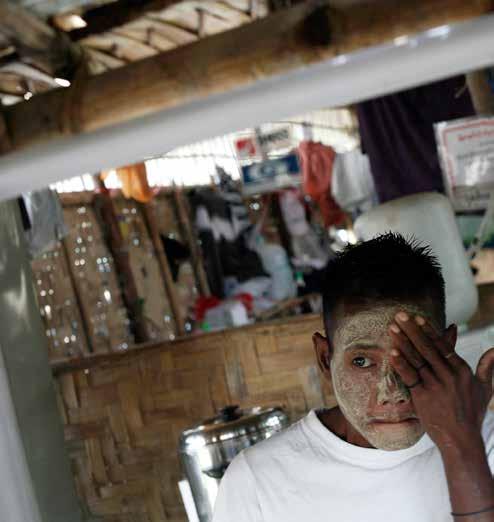
“Too often big donors impose their own agendas, undercutting local initiatives.”
to accept local leadership in development programs. What do you think are the reasons for this?
Some international agencies are very close to the UN and donors’ agendas. Others are closer to the reality and are supporting local actors. It is time for the international agencies to acknowledge the local NGOs and work hand in hand with them on
joint strategies, and with mutual recognition.
You made a statement in a number of places last year that “armies can sign ceasefires, but only the people can create a peace.” Do you see signs that this is better understood now?
Yes, I have been emphasising repeatedly the need to recognize the difference between ceasefires and peace.
“Peace” is a social state and cannot be developed by military men, and cannot be developed without the leadership and will of the people—they must build it and live it.
That is why I talk about a unified front. All ethnic nationals within the Union must come together to resolve the root causes that led to the present conflict. We need to break the cycle of armed conflict, militarization, human rights violations, displacement, resettlement, poverty, illegal migration, low wages, human trafficking, illicit drugs and corruption—the list could go on— or it will never be broken and continue to drag down the next government, which will be unable to stop exporting its own difficulties and crises to the whole region.
Encouragingly, there are processes taking place now and the civil society network is better than at any time in our country’s history.
The current ceasefire process is looking uncertain. What are your views on this?
The turmoil that Myanmar has witnessed during the last four years could be doubled or even tripled in 2015 if efforts towards peace and reform do not succeed. I am, therefore, gravely

concerned about the recent situation and believe in building a robust civil society as the most effective response to the challenges that we are facing.
Whatever happens, even if national institutions in government and politics become weakened, with a strong civil society we can surely overcome this and rebuild. I have been saying all along that, in the Myanmar context, strengthening civil society and building peace are interdependent.
All efforts should be made to ensure that the future to come will be built from today onwards: by providing quality education, dignified sustainable livelihoods, and respect and promotion of the rich cultures that define our identities across the different ethnic nationals that compose the mosaic of the Union of Myanmar.
What is the main focus of your work these days?
The central purpose of my life will always be to support people’s processes to build a strong and sustainable civil society, in peace, and with full entitlement to their rights; that is true justice.
I have been advocating aid agencies’ need to continually assess their capacity to follow their mandate and to reflect on the current humanitarian system in Myanmar.
I have used the US$50,000 prize money that came with the 2013 Ramon Magsaysay award as a seed fund to launch a new initiative that will ensure that the Ayeyarwaddy River continues to flow far into the future, and that just as the mighty river connects all diverse ethnic nationals, it will inspire us to come together in unity in striving for the peace and prosperity of our nation.
“It is essential to recognize that local organizations need core funds.”Local aid: An HIV positive man puts on thanaka paste in front of a mirror at an HIV/AIDS hospice, founded by a member of the National League for Democracy party, in the suburbs of Yangon in December 2012. PHOTO: REUTERS
Since 2011, Myanmar has become the recipient of a huge amount of new development aid. That means large amounts of money are now committed to health, education, humanitarian aid, infrastructure, services and many other sectors of society in which improvements are desperately needed. So how can the public find out more about what is being done, and where?
Myanmar signed up last year to the International Aid Transparency Initiative (IATI), a voluntary aid transparency measure, and now a new website has become accessible online that gives preliminary information on aid commitments in the country since 2011.
Around 80 percent of overseas development aid has been recorded on the site which is under the auspices of the Ministry of National Planning and Economic Development, according to the European Union Delegation to Myanmar, which funds the initiative.
According to the mohinga.info website, which is still in the beta stage, $US5.31 billion in aid has been committed by development partners in Myanmar within the date range of January 2011 to December 2015, as reported by them to the mohinga.info system.
The website provides graphs showing the amounts allocated to the different states and regions, as well as the origin of the money being spent, and the amounts committed to different sectors.
According to the EU delegation, the site is still “very much” a work in progress and its compilers struggled to overcome some hurdles getting it to this point.
Though the site was supposed to be able to import data directly from the IATI, it was found that “many development partners weren’t yet reporting accurately or in detail (or
indeed at all)” to the international standards group, according to the delegation writing in a blog in February.
That meant that the Myanmar team had to input data manually instead. Recording multi-donor trust funds accurately without double-counting was also a headache.
Global development organizations preach the importance of transparency to the governments and community organizations with whom they work. Yet in practice it is often extremely difficult for citizens and media to access useful information about projects and work being undertaken by the aid donors and organizations themselves.
That makes the new site a welcome beginning for increased aid transparency in Myanmar, where for decades almost all forms of data was unavailable to the public.
The delegation said there was a plan to publicize the site widely to ensure that more people could access and use it.
Meanwhile, the information currently available makes for useful, and at times intriguing, reading. As is the case with most data, the information raises as many questions as it answers.
Japan is by far the biggest aid donor to Myanmar, committing over US$2 billion from 2011-15.
The allocation of aid across different parts of the country is also interesting. Why does Chin State receive three times more aid than Rakhine State? How come tiny Kayah State receives more than twice as much aid as its much larger neighbor, Kayin State?
It is to be hoped that answers to questions such as these and many others will emerge as the mohinga.info site develops and is used more by the public, the media and others. Time to start browsing. —The Irrawaddy
*The US$5.31 billion figure represents the total volume of commitments made thus far for the date range between January 2011 and December 2015, as reported to the mohingya.info system. The system is currently presented with a disclaimer explaining that the data depends on donor partners voluntarily submitting information on a continual basis, and that it is a workin-progress. Because some donors report aid as “nationwide” rather than by state or region, the figures for each territory do not align fully with the total aid figure.
Billions of aid money is being spent in Myanmar, but where exactly is it going? A new website aims to shed some light.
JAPAN
WB EU
UNIDENTIFIED
USAID
DFID (UK)
• Yangon Region with 14.3% of the population is receiving around 20% of the total aid to the country.
• Chin State with 0.9% of the total population is receiving three times more aid than neighboring Rakhine State with 6.2% of the population.
• Kayah State with 0.6% of the population is receiving well over twice the aid to neighboring Kayin State with 3.1% of the population.
• Naypyitaw with 2.3% of the population is receiving US$149.43m; much more than either Kayin, Rakhine or Mon States, and Tanintharyi Region.
• Shan State with 11.3% of the population is receiving more than one third of all aid to all the states. Rakhine, Kachin, Mon, Kayin, Kayah and Chin states combined, with 18.1% of the population, are receiving $771.70m.
*'Data-Points to Ponder' was compiled by The Irrawaddy based on information on mohinga.info and the recent census.
DFAT (AUSTRALIA)
ADB
INDIA
GOV.GERMANY
SDC (SWITZERLAND)
UNICEF-RR
SIDA (SWEDEN)
UNICEF
GOV.ITALY
MULTI
DANIDA
KOICA (SOUTH KOREA)
Sayadaw U Nayaka’s achievements on free and progressive education are matched by his determination to accomplish even more

 By ZARNI MANN / MANDALAY
By ZARNI MANN / MANDALAY
About 25 young schoolchildren in white and green uniforms stand face to face in the classroom. They point at each other enthusiastically as they practice the personal pronouns “You” and “I” while their teacher patiently provides corrections and encouragement.

In another classroom for thirdgraders, some 20 students practice maths, brainstorming in English with their teacher. In another, children in small groups are playing a game with
cards bearing pictures of animals, fruits, vegetables and colors.
These are everyday classroom scenes at the Phaung Daw Oo Monastic School, located east of Myanmar’s second-biggest city of Mandalay, where in some classes, young Buddhist novices, nuns and other children all learn together.
The school began with a simple idea—“A free education for everyone”— and each year, students from near and far enroll, from kindergarten to
high school level, learning the same curriculum as other local government and private schools.
One of the defining features of the Phaung Daw Oo school is its “child centered approach” to education, led by school principal and the Abbot of Phaung Daw Oo Monastery, Sayadaw U Nayaka, who has also sought to deemphasize traditional practices of rote learning.
“It was around 1967, when I was about 20, that my younger brother Zawtika and I saw a huge Christian missionary school in Hinthada, Ayeyarwady Region, which was then a government school,” U Nayaka said. “We later found out about

missionary schools and their idea of free education inspired me to run a monastic school.”
For centuries, monastic schools were the only source of education for Myanmar’s youth until missionary and private schools were established during the British colonial period. Following the military coup in 1962, the popularity of monastic education dropped significantly in cities and towns across the country.
In order to achieve his dream of educating others, U Nayaka first had to educate himself. At the age of 24, he left the monastery in Mandalay to pursue a secondary education in a government school in Pyaw Bwe, Mandalay Region.

“To teach others, I had to learn the modern education [system]. I was the oldest person in the class. However, I was never disappointed to learn,” he said.
He remained in the monkhood throughout his secondary schooling and went on to study chemistry at Mandalay University, graduating in 1981.

In the early 1990s monastic schools regained popularity, particularly among children whose families could not afford regular school fees.
After being appointed as an abbot at Phaung Daw Oo monastery, U Nayaka and his brother U Zawtika, established the free monastic school for primary school children in 1993, registered under the Ministry of Religious Affairs.

In the beginning, teaching methods at the new school mirrored those of other government-run schools.
“As the years went by, I felt like something was still missing,” U Nayaka said. “Around the year 2000, when I learned about the child centered approach, I decided to change the teaching methods in my school.”
With the help of donors, U Nayaka sought foreign educators to help train local teachers. His emphasis on a child centered approach was quickly embraced by students, while parents initially remained skeptical.
“We received several complaints from parents that their children were getting very inquisitive, did no homework, [and that there were] fewer lessons in their notebooks than [students] in government schools,” U Nayaka said.
“We had to explain the child centered approach to them, which is not a ‘parrot learning’ method, and that the idea is to learn, not just writing notes.”
The school later expanded to incorporate a high school and in recent years has had around 6,0007,000 students enrolled each year, including orphans, ethnic children and children affected by Cyclone Nargis.

Around 300 local volunteer teachers are on hand each year, including foreign teachers from countries including Germany, the United States, Australia and the United Kingdom.
But it has not always been smooth sailing for Phaung Daw Oo’s students, some of whom have found their exam results don’t always stack up against students in government schools.
Jasmine, who attended the Phaung Daw Oo school since kindergarten, recently received the results of her matriculation exams.
“I received no distinctions and was quite disappointed. From a young age, what we learn here is based on creative thinking and critical thinking. We never learn the lessons by heart; we rewrite it or present it in our own words,” she told The Irrawaddy.
“But for matriculation exams, we can’t do that. We have to learn everything from A to Z, by heart, and have to write it down [exactly] as it is,” she added.
U Nayaka said a governmentled focus on rigid examinations discourages many students like Jasmine who are not familiar with the rote learning system—or, memorization based on repetition.
Only 30 percent of students from the monastic school passed the matriculation exams in the 2014-15 academic year, and only 185 students obtained distinctions.
After passing their final exams, students still face an uphill battle to gain entry into university, with places usually awarded according to examination marks.
“Since the total scores of our students are not comparable to the students who passed under the [rote learning] approach, most of them can’t usually study [subjects] like medicine, engineering or IT which require very high total scores,” a teacher at the school explained.
U Nayaka has his own possible solution: He dreams of opening a private, international-standard university offering free education.
“I think: what will these students do after they graduate from our high school? Most of them came here because they can’t afford tuition fees. Some of them can’t go to those universities because of their marks, but they are smart enough to become professionals,” he said.
U Nayaka’s plans stalled however, after the female donor of 400 acres of land for the site of the planned university in Mandalay Region’s Patheingyi Township was jailed in relation to the donation.
The Abbot’s vision has shifted
slightly to other forms of higher education.
“Currently, we are planning to open a pre-college class for the students and teachers who will go abroad for further study. Now we are testing the class, first with the students who graduate from our high school, and then we will allow outsiders later,” he said.
In Myanmar, monastic schools are the most popular option for poor or disadvantaged students. According to official figures for 2014, there are an estimated 7,000 teachers and more than 260,000 students enrolled in some 1,579 monastic schools nationwide.
The Phaung Daw Oo Monastic school motto is clear and simple: “Free and better education for everyone.” It takes pride in an inclusive approach, without prejudice based on gender, race or religion.
“Education is just education. We can’t mix it up with religion. In our school, we teach no students to be racists,” U Nayaka said.
“Our education system has been spoiled for many years so that our children can’t catch up to international levels. My belief is that with better education, with smart and welleducated people, we can create a better community, a better country.”


The government’s hopes of finalizing a nationwide ceasefire agreement before this year’s election appear to have shrunk considerably, after last month’s ethnic summit in Law Khee Lar in Kayin State voted to cede negotiating power to a new “hardline” committee.

From the perspective of government peace negotiators, two problems have arisen from the June 2-9 Law Khee Lar summit. First, ethnic leaders have refused to endorse the draft ceasefire text, demanding fresh negotiations over 15 amendments. Second, the new negotiating committee, which will assume the responsibilities of the Nationwide Ceasefire Coordination Team (NCCT), is comprised of people likely to be much less receptive to government overtures.
“We prefer to deal with the NCCT instead of a new committee,” said U Hla Maung Shwe, a director of the Myanmar Peace Center. “The NCCT members have become friendly with us already. But now they have formed a new committee and replaced the leaders. This could be a problem with our government as it will take time to build rapport, and the people leading the new committee are hardliners.”
The government has positioned the successful conclusion of a nationwide ceasefire agreement as one of the most important ambitions of President U Thein Sein’s tenure, but ethnic armed groups remain aloof, cautious of committing themselves to an accord
that would impede their push for a federal reform of the Constitution.
“Of course, the president wants to pass his exam,” said NCCT chief Nai Hong Sar. “He would be credited for being able to bring a ceasefire agreement during his term. But for us, we are worried that we will be trapped by the government after the agreement is signed.”
The formation of a new negotiating coalition is indicative of majority opinion at the Law Khee Lar summit. Ethnic leaders believe that the government has not made enough concessions to warrant signing the
ceasefire accord as it stands. For that reason, the new committee will be headed by Naw Zipporah Sein, the vice-chair of the Karen National Union (KNU), with Dr. Laja of the Kachin Independence Organization (KIO) as her deputy. Both spent time on the central executive committee of the United Nationalities Federal Council ethnic coalition, and both are representatives of factions less amenable to compromises with the government within their respective organizations.
On the sidelines of the Law Khee Lar summit, ethnic leaders appeared to be rankled by what they saw as pressure from the international community to sign an accord sooner. KNU member Naw May Oo Mutraw reportedly lashed out at UN envoy Vijay Nambiar, claiming that the international community did not understand the reality of the situation faced by ethnic armed groups in Myanmar.
Sources close to the organizations said that both the KIO and KNU, the political wings of two of the most powerful ethnic armed groups, had decided to withhold any agreement to sign the nationwide ceasefire deal until the general election expected later this year is demonstrated to be free and fair, and would not yield to any international pressure to expedite the process.
At the same time, the international community may prove to be a sticking point in future negotiations for very different reasons. Ethnic leaders want international observers present to witness the signing of the nationwide ceasefire agreement, while the government has rejected calls for their oversight, saying that a ceasefire accord is a purely domestic affair. The issue came up during previous negotiations between the government and the NCCT, before it was struck from the draft text of the ceasefire agreement unveiled on March 31.
Other exceptions to the draft text also emerged at the summit. Ethnic leaders resolved to have provisions relating to a federal army included
in any ceasefire agreement. As with other issues, this was excluded from the draft text after negotiations in the expectation that a settlement would be reached after the accord was signed.
Some leaders at Law Khee Lar criticized the draft text for lacking strong guarantees of political rights for ethnic groups, and said an agreement could not be signed without more explicit commitments on this front from the government’s Union Peacemaking Working Committee (UPWC).

Khun Okkar, a member of the NCCT, said he was skeptical of the new committee’s ability to secure more concessions from the government, but said the previous negotiators would abide by the summit’s decision.
“Some leaders thought that they could push for more rights, and this is why they told us to step down and let others talk to the UPWC,” he said. “We worked the best we could and it took a year and a half. Let them try, they may understand afterwards that it is not easy to talk with the military.”
He noted, however, that some of the ethnic leaders at the summit wanted to sign the nationwide ceasefire agreement as it stood, without waiting for three armed groups that had been excluded from negotiations by the government.
U Hla Maung Shwe warned that the government might not be willing to accept either a new negotiating bloc or a new discussion on amending the ceasefire text, noting that a date and time for further negotiations had not yet been set.
“They should have proposed [the amendments] before, why are they just proposing them now?” he asked. “This could be a problem. I feel the government might not accept this.”
Though his own position will eventually become redundant if the new committee proceeds, Nai Hong Sar said that the decision was in the hands of ethnic leaders and not negotiators.
“[The NCCT] cannot do anything,” he said. “Even if the government cannot accept the new committee or sign our draft text, this was the majority decision made by ethnic leaders.”
negotiating bloc.
A TAXING TRIP: Nine checkpoints on a 90-minute journey

Women are “a force for national development” says Ma Nang Lai Kham of the Kanbawza group of companies

Founded in 1994 by U Aung Ko Win, the Kanbawza (KBZ) Group of Companies manages a diverse set of business interests, including in mining, banking, real estate, aviation and insurance. The eldest daughter of the firm’s founder, Ma Nang Lai Kham, cut her teeth working at KBZ Bank, one of the largest private financial institutions in Myanmar, with nearly 200 branches across the country and with 113 billion kyat (US$101.9 million) in capital as of 2014. She has risen to become the chairwoman of Brighter Future Foundation, Air KBZ, KBZ Bank and Kempinski Hotel Nay Pyi Taw under the KBZ group of Companies. Ma Nang Lai Kham spoke with The Irrawaddy’s Kyaw Hsu Mon about the role of women at Kanbawza, promoting women business leaders and encouraging women’s participation in all sectors of the economy.
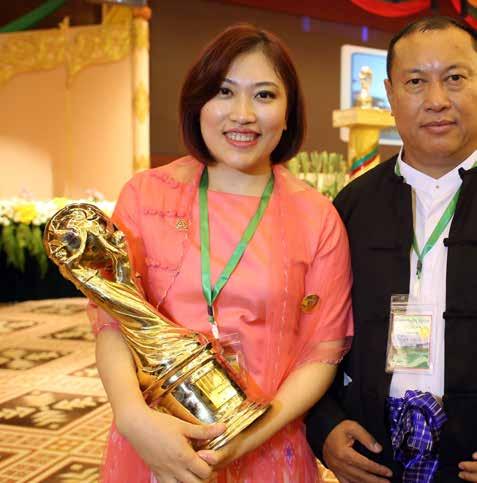
Women are playing a greater role in Myanmar’s economic life. What challenges do they face?
As the country has developed more and more and connected with the international community, people’s horizons have expanded. There are lots of opportunities for everyone now. Women account for 51.8 percent of the national population. Previously, women were stereotyped as housewives once they were married. But now, a certain number of women are leading businesses shoulder to shoulder with their male counterparts. Women now play an important role in the economic development of Myanmar and they are a force for national development.
What policies should companies adopt to enhance the role of women in the workplace?
I would like to talk about an empowering culture rather than a policy. I would encourage every staffer, regardless of their age and gender, to exercise discretion and take responsibility rather than adopting an overall policy for an entire company. On a level playing field, we award and give promotions to female staffers depending on
their competence, performance and expertise. In Kanbawza, we nurture a culture that provides equality and nondiscrimination on the ground of gender.
I believe that a large number of Kanbawza staff are women. Can you tell us about this?
Women account for 85 percent of staff in our Kanbawza Insurance Co. and about 53 percent for Kanbawza Bank. Women share senior positions with men in our company.
Married female staffers are entitled to maternity leave, fixed health allowances, plus leave to take care of their newborn babies if necessary. In addition, we assign duties that are appropriate for them when they return to work. We don’t transfer them to places far from their families.
We also provide training and do not discriminate on the ground of gender in providing training. We award staffers depending on their performance and expertise. Interestingly, 35 percent of customers who take loans from Kanbawza Bank are businesses that involve or are led by women.
How important is parental support to women who want to become successful businesswomen?
The guidance and support of parents are fundamentally important for a child to have success in life. On the other hand, a child who gets support from her parents needs to have interest in the business and devote tireless efforts. And she also needs to have big ambitions.
What do you expect will be the challenges as a young woman in relation to inheriting your family’s businesses?
Challenges exist everywhere, especially in Myanmar which is developing fast. We need to hand down a great deal of knowledge from generation to generation and systematize our companies for further development.
I, together with my sisters, had to work almost daily at the bank branches to be familiar with the job since we were young. To make sure there is no generation gap, we coordinate with our parents. For our business to last long and succeed, we need new ideas for each business. As the first generation has established the business, the second generation has to maintain the success and should have entrepreneurial skills.
We have joined the Business Families Institute in Singapore and have adopted strategies for the greater success of our company. We also attend and take part in discussions at the World Economic Forum’s New Champions.
What is your educational background?
I studied basic education at Teacher Training College. Then I did a bachelor degree in business administration at the National University of Singapore. At present, I am studying a Master of Management at the University of Sydney in Australia. I intend to play a part in social and economic sectors important for building a developed country.
You have participated in highlevel discussions on the role of women here. Can you tell us more about this?
You can see that women are taking a lead role not only in business but in other sectors. At Myanmar Investment Outreach Forum held in September 2014 in New York in the US, we held a wide ranging discussion together with Melanne Verveer [Georgetown Institute for Women, Peace and Security Executive Director] and businesswomen from other organizations on expanding the role of women in Myanmar’s economic sector, capacity and opportunities for women and the role of women in Myanmar society.
Again in December 2014, the Women’s Forum Myanmar was held in Naypyitaw and Yangon. The forum was attended by male and female leaders from various fields at home and abroad. The two-day forum included frank discussions on a wide-range of
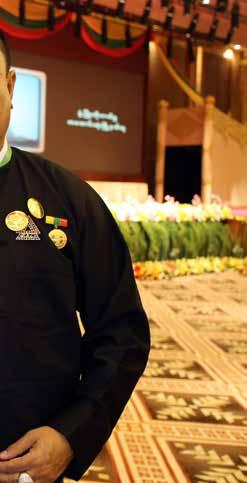
topics. Our country is weak in raising awareness and cooperation. Such forums should be held in other regions and states to unlock opportunities for women.
What is your understanding of glocalization and Myanmar?
Glocalization is adapting global economic concepts to regional needs. Since culture differs from one country to another, we need to maintain national identity and tune international economic concepts in to Myanmar culture so that we can keep abreast of international countries.
After 2011, Myanmar expats came back to the country along with their knowledge, experience, expertise and they could be tuned in to the specific needs of customers together with their local partners. Some difficulties they have faced working together with their local partners are that work procedures and social relations in the workplace are different.
You are serving as chairwoman of Myanmar Future Ray of Light Foundation. What does this involve?
We are engaging in a wide range of sectors including education, health, sports, poverty reduction, empowering persons with disabilities and youth development. We also provide help for internally displaced persons, victims of trafficking and disasters, and also help migrant workers return home. Like Forum-CEO Champions, we have formed Women’s Forum-CEO Champions Myanmar with male and female businesspersons to encourage the role of women in the economic development of Myanmar.
Women account for 85 percent of the staff at Kanbawza Insurance Co. and about 53 percent of staff at the bank.
For this recent bus traveler, it cost 2,000 kyat (US$1.80) to secure smooth passage to Yangon from the Myawaddy border town in eastern Kayin State, using a new section of the planned Asia Highway 1 network for the first part of the journey.
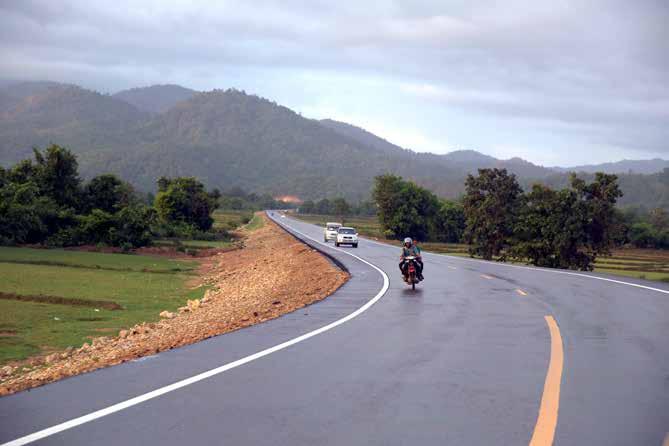
On our minibus with 14 passengers, that meant nearly $30 in total went
to a broker, ethnic armed groups and the Myanmar Army over nine checkpoints on the 90-minute drive from Myawaddy to Kawkareik.
Drivers can choose to pay up at each individual checkpoint, or to do as we did—hire a “road broker” to handle the soldiers stationed at informal toll booths along our section of the Asia Highway 1, a series of envisioned road
links stretching nearly 13,000 miles from Tokyo to Turkey via Southeast Asia.
Our driver said that the 40-year-old woman enlisted to be our facilitator was close to the three ethnic Kayin armed groups that levy fees on the route: the Democratic Karen Benevolent Army (DKBA), Karen National Union (KNU) and Karen National Liberation ArmyPeace Council (KNLA-PC).
“They are bad guys, and they talk very aggressively sometimes; this is why I do not want to talk to them, and let her deal with passing checkpoints,” he said.
The taxes can vary, depending on the type of vehicle and passenger load. For our minibus, 13,000 kyat in total was extracted at nine checkpoints, with the rest going to the broker.
Such is the arbitrary nature of the system—or the brashness of the soldiers—that our driver apparently
preferred to pay twice as much for a no-hassle journey.
Motorbikes, a common form of transportation in the region, are charged 1,000 kyat per checkpoint, making the full journey from Myawaddy to Kawkareik a 9,000 kyat expenditure.
Talk to locals who ply the route frequently and it’s clear that this system of informal taxation rankles.
The highway is publicly funded, with assistance from the Asian Development Bank (ADB), and thus should be a public good, they argue.
Asia Highway 1 is not yet officially open, but that hasn’t stopped vehicles from taking advantage of the new route, which can be driven in about one-third the time of the old road.
Drivers are taxed by plainclothes personnel at Myanmar Army checkpoints, but the ethnic Kayin armed groups make no such effort at subtlety, with fully uniformed, guntoting soldiers from the KNU, DKBA and KNLA-PC manning the posts.
Noncompliance is met with the threat of being turned back.
Thwarting the designs of those who envisioned the Asia Highway 1 facilitating the more efficient movement of goods in country and transnationally, trucks are avoiding the route.
“For 10-wheeled trucks, the driver has to pay 100,000 [kyat] total. This is why none drive on this highway, because they have to pay a high tax,” said another driver.
Commercial trucks instead take the old road, where a far less hefty levy is enforced.
The ethnic Kayin armed groups in the area are powerful and in May, U Zaw Min, the chief minister of Kayin State, was temporarily held at gunpoint

by the DKBA after failing to declare his travel plans in territory it controlled.
Kwar Htoo Win, who is general secretary of the KNU, was asked about the taxation during a recent ethnic summit in Law Khee Lar, Karen State, but the KNU leader ignored the question.
Karen News, based on the Thailand-Myanmar border, reported recently that the three Kayin armed groups hosted a meeting in late May to discuss consolidating their checkpoints in future, after fielding numerous complaints of their proliferation along the highway. The armed groups reached an agreement on the matter, according to Karen News, though the details of the agreement were not revealed.
Rakhine parliamentarians were preparing in mid-June to propose that the regional legislature discuss the awarding of tenders for the Kyaukphyu special economic zone (SEZ). The announcement of the winners was first expected at least six months ago but has been beset by delays.
“We discussed the Kyaukphyu SEZ last November in the state parliament,” said U Kyaw Lwin, a lawmaker from Kyaukphyu Township. “The SEZ development committee explained the project then, but we don’t know what is happening at the moment.’’
A spokesperson for the Kyaukphyu SEZ bid evaluation committee told The Irrawaddy in March that the project was still in the “negotiations stage” with potential tender winners.
“There has been no transparency in this SEZ project since the beginning stage. If this project is not beneficial for Arakanese, we will have to stand by the people,” U Kyaw Lwin told The Irrawaddy in June, reflecting perceptions that the terms of the SEZ deal might benefit tender winners at the expense of the local population.
U Aung Myat Kyaw, a parliamentarian from Rakhine State’s Sittwe Township, said the Kyaukphyu SEZ’s bid evaluation committee owed lawmakers an update on the status of the tenders.
“As far as I know, a Chinese company is a prospect. If the government grants
[the tenders] to a Chinese company, they will take a lot of its benefits from us,” U Aung Myat Kyaw claimed.
“We’ve discussed it in the state parliament before; at that time, we felt that the Chinese wanted more [generous] terms, like to take 80 percent interest from this project,” he added.
Three contracts will reportedly be awarded for development of the site’s deep-sea port, a petrochemical processing plant and a variety of industrial factories.

Wariness over the SEZ is fueled in part by locals’ experience with the dual “Shwe pipelines,” which pump oil and natural gas from a terminal at Kyaukphyu across Myanmar to a fuel depot in China’s Yunnan province. Displacement resulting from the pipes’ construction, concerns over environmental degradation and the terms of the Shwe pipeline deal—with China receiving all of the oil and natural gas that passes through Kyaukphyu—have made the project unpopular among the local population.
Myanmar’s government called for Kyaukphyu SEZ infrastructure tender bids in September 2014. Bidding closed on Nov. 24, with a total of 12 proposals submitted by one local and 11 international firms.
An announcement of the tender winners was initially expected in
January, later pushed back to February. That deadline also came and went, with the spokesperson for the SEZ’s bid evaluation committee saying in March that an announcement at the start of the next fiscal year was more likely.
“We have to be cautiously negotiating with this bidder, because it’s a huge project,” a spokesperson for the Kyaukphyu SEZ bid evaluation committee told The Irrawaddy in June, seemingly indicating that all three tenders would go to a single bidder. “If we make the wrong decision, it will cost us in the long term.”
“But I expect that it can be announced before the next government’s term,” he added, declining to say which companies had been shortlisted for the tenders.
A new government is expected to be sworn in by the end of March next year.
“The huge project should bring equal rights for both country and bidder,” the spokesperson said.
An industry source has predicted that China’s CITIC Group is likely to be awarded at least one of the three tenders up for bid. It is a known contender,
having produced a feasibility study in 2011 that estimated project costs at US$14 billion and a land planning area of about 217 square miles.
The Kyaukphyu SEZ is one of three major economic zones planned for Myanmar and will serve as a key
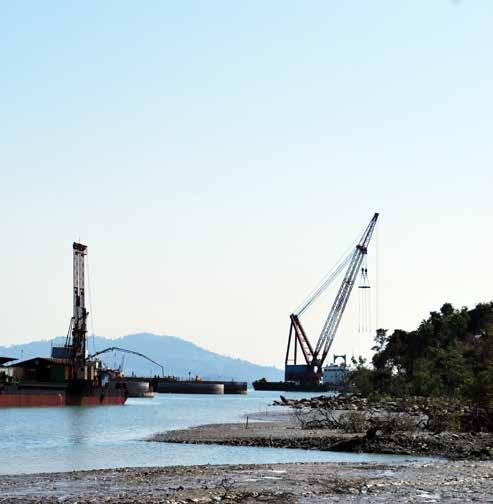

feature of the Shwe pipelines energy corridor, transferring gas sourced from the Bay of Bengal and oil shipped from elsewhere into China’s isolated southwestern provinces. The overland shipments of crude oil could eventually save China millions by avoiding long and costly tanker routes through the Malacca Strait.
With the SEZ bidding process dragging on, locals are also scrutinizing oil and gas exploration and production off the coast of Rakhine State.
The Arakan Resources and Environmental Network, a local advocacy group, called for the halting of nine offshore oil and gas fields that it says are being operated without the consent of local people. The network called for direct management of Rakhine State’s resources by the state government.
Additional reporting by San Paw.
“This huge project should involve equal rights for both country and bidder.”
–Spokesperson for the Kyaukphyu SEZ bid evaluation committee
Myanmar’s state-owned flag carrier announced in June that it will offer direct flights from Yangon to Singapore beginning in August.
Coinciding with the induction of one of 10 new aircraft into its fleet, MNA said the new planes will link the company’s 26 domestic destinations with an expanding international network.
Four other cities in the Asia Pacific region will join the Myanmar National Airlines (MNA) international network in early 2016, the company said in a press statement.
Myanmar’s premier insurance providers will begin offering health coverage on July 1, beginning a one-year pilot project approved by the Ministry of Finance.

Eleven licensed private insurers will soon offer coverage at a standard rate of 50,000 kyat (US$45) per unit per year with a maximum of five units. All healthy citizens between the ages of six and 65 years will be eligible during the first year trial.
“We will adjust the health insurance regulations during this first year,” Deputy Finance Minister U Maung Maung Thein told reporters.
Initial policies contain some restrictions on eligibility and
applicable services, the deputy minister said. Coverage will not extend to abortion, child delivery, dental, eye or cosmetic surgery, and treatment for mental illness and drug addiction will be exempt. Maximum yearly compensation will be standardized at 5 million kyat for individual subscribers. Customers will not be reimbursed for treatment in foreign hospitals, providers said. Insurers will be free to offer benefits to employers, such that they can purchase monthly plans with a maximum payout of 15,000 kyat per day for up to 30 days of treatment for employees.
Kyaw Hsu MonIndonesian conglomerate Lippo Group plans to build 20 private hospitals in Myanmar and is working with local tycoon Serge Pun in the country, according to the Jakarta Globe newspaper.
The two firms have entered a joint venture to set up the 174-bed Pun Hlaing Siloam Hospital on the tycoon’s Pun Hlaing Golf Estate in western Yangon, a recent report said.
The Jakarta Globe report quoted James T. Riady,
Last year the company secured six Boeing 737-800s and four 737 Max aircraft in a US$960 million deal with GE Civil Aviation Services, the largest commercial deal between the United States and Myanmar in decades.
MNA, formerly called Myanma Airways, was incorporated in 2014 as Myanmar’s sole flag carrier and was authorized to operate both domestic and international routes. The airline currently has the largest domestic network in Myanmar.
The new international route will bring MNA into competition with two other local carriers serving Singapore. Myanmar Airways International (MAI), owned by KBZ Chairman U Aung Ko Win, offers seven international destinations including Singapore. Golden Myanmar Airlines, owned by CB Bank Chairman U Khin Maung Aye, serves Singapore and Thailand. —Kyaw Hsu Mon
CEO of real estate giant Lippo Group, saying that the company would spend US$1 billion in the next three to five years to build 20 medical facilities both in Yangon and elsewhere in Myanmar.
“We will build six to seven hospitals in Yangon, while the rest will be outside Yangon,” Riady reportedly said. “The investment value of one hospital including the land is around $50 million.” —Simon Lewis
Myanmar’s rice exporters will attend an exhibition in Milan late this month for the first time, hoping to promote Myanmar rice in Italy and other European markets, according to the chairman of the Myanmar Rice Federation (MRF).
Though China is Myanmar rice exporters’ biggest customer and looks likely to remain on top for some time, MRF chairman U Chit Khine told The Irrawaddy that the European Union beckoned as Myanmar looks to ramp up exports of the staple grain.

“The EU market has potential and we need to extend our network by taking part in these kinds of exhibitions,” said U Chit Khine, adding that he hoped to make a major push into the market next year.
In 2013, the European Union designated Myanmar eligible to benefit from its Generalized System of Preferences (GSP), eliminating duties on imports from the Southeast Asian nation. One factor preventing a more robust growth in exports to Europe has been the low quality of Myanmar’s rice exports, with much of the product failing to meet EU standards.
Ongoing upgrades to domestic rice mills would help to
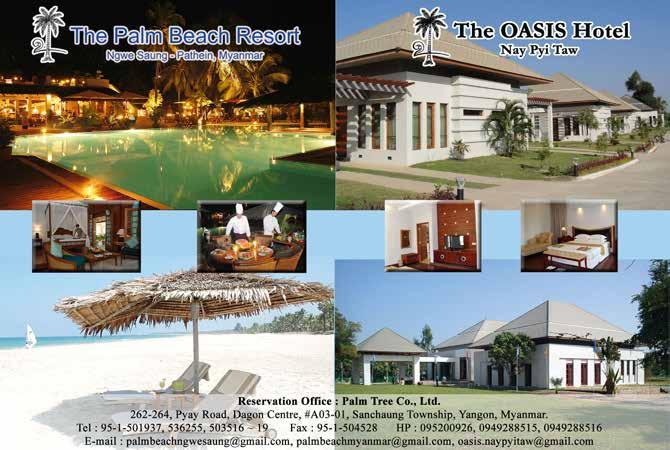
make up for that shortcoming, according to U Chit Khine.
U Soe Tun, chairman of the Myanmar Farmers Association, said the Ministry of Commerce is backing rice exporters’ more aggressive effort to court European buyers. —Kyaw Hsu Mon
Sri Lanka’s new mangrove protection scheme, the world’s first country-wide initiative, is relying on women like Michel Priyadarshani, head of a fisherwomen’s group in eastern Ambantotam village.
Ms. Priyadarshani and her colleagues did not understand the importance of mangroves for the ecosystem, including the fish population, until they benefited from a program offering microcredit in return for looking after the coastal forests.
“Now we know—and from us, our husbands and our community also have become aware,” Ms. Priyadarshani said.
Since 1997, Sudeesa, a national organization that works to protect coastal ecosystems, has given women living near mangrove forests financial assistance—mainly loans of US$50 to $2,000 each—incentivizing them to care for the delicate trees.
Now the program is about to go island-wide. Sudeesa, together with the Sri Lankan government and USbased environmental conservation group Seacology, recently launched a five-year, $3.4 million mangrove preservation initiative.
Sri Lanka is the first nation to promise to protect all its mangroves, experts said.
Mangrove trees grow in saltwater, forming a vital part of the natural cycle

in coastal lagoons. Fish and other marine creatures like prawns use the deep roots as breeding areas.
The forests protect coastal communities from abrupt tidal shifts and storms, while slowing shore erosion.
“People who live near mangroves tell us the trees act as a buffer against the wind and heavy rains, breaking their intensity just before they make landfall,” said Douglas Thisera, director for coastal conservation at Sudeesa, formerly known as the Small Fishers Federation of Lanka.
Mangrove swamps also store carbon, sequestering it in the top few meters of underwater soil and keeping it there longer than other trees.
K. D. Wijitha, who runs a group bringing together women from 23 villages in the northwestern Kalapitiya area, said they had learned to look after the mangrove forests.
“We make sure that they are safe,” she said.
Mangroves form a vital part of local ecosystems throughout much of coastal Asia, as the intricate systems slow soil erosion, provide breeding grounds for marine creatures and protect coastal communities from large tidal shifts and storms. Here, a man works in a mangrove forest near Bangkok in Thailand.
Thanks to the Sudeesa program, Kristina Jospin from Samadigama village in northwestern Puttalam District received training and financial aid to operate a small bakery, which allows her to support her sick husband and four children.
Sudeesa credit officer Suvinetha de Silva said the program usually targets the poorest women, who are unable to seek credit from banks.
The new national scheme aims to set up 1,500 community groups around Sri Lanka’s 48 lagoons, which will offer alternative job training and microloans to 15,000 people. The groups will be responsible for the upkeep of designated mangrove forests.
Pilot projects showed a high success rate, said Duane Silverstein, executive
Backed by a
scheme, women are leading what experts say is the world’s first nationwide mangrove conservation
director of Seacology. Almost 2,000 loans were made to women, with a repayment rate of over 96 percent.
“With very small loans of around $100, several of the women were so successful that they already employed additional women,” he said.
Half of loan recipients under the new program will be widows, while the rest will be male and female school dropouts.
Seacology and Sudeesa officials said each community group will be responsible for around 21 acres (8.5 hectares) of mangrove forest. The government has agreed to provide rangers to patrol the forests.
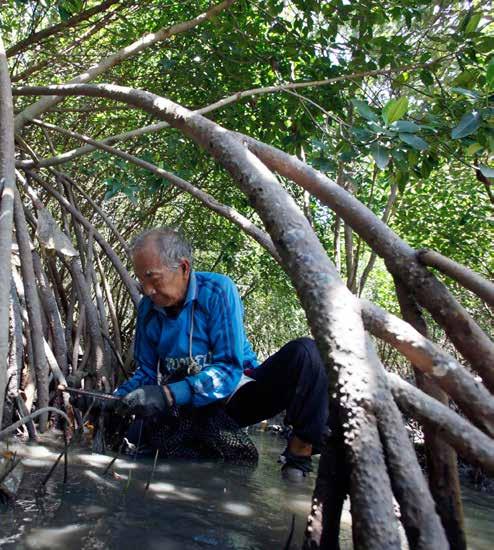
The program also plans to replant 9,600 acres (3,885 hectares) of mangroves.
The new government of President Maithripala Sirisena has brought the island’s 21,782 acres (8,815 hectares) of mangroves under the Forest Ordinance Act, making it illegal for anyone to exploit them for commercial purposes.
“It is an extremely vital decision because now all mangroves around the island can be protected with the active participation of the Forestry Department,” said Sudeesa chairman Anuradha Wickramasinghe.
Some three decades ago, Sri Lanka had at least 40,000 hectares (98,842 acres) of mangroves, Mr. Thisera said. But the bulk has been destroyed due to
use.
“The biggest threats to mangroves in Sri Lanka include prawn farms, which have been greatly curtailed in recent years, collateral damage from the civil war, and impoverished people cutting down mangroves to use or sell as charcoal,” Seacology’s Mr. Silverstein said.
The worst damage occurred in the northwest of the island nation, where commercial prawn farms took off in the 1990s. But most of these farms have been abandoned in the last few years due to the spread of disease.
The new mangrove protection scheme plans to introduce other trees that can provide an alternative fuel source, such as coconut husks.
Silverstein said the government’s enthusiasm for protecting the mangrove forests could push other countries in the region to follow suit.
Defense Secretary B.M.U.D. Basnayake told Mr. Silverstein the national armed forces could help with replanting efforts.
Mr. Wickramasinghe said the program’s success would depend on how far local communities buy into it.
“We have to make them understand the mangroves are a boost to their lives and their incomes,” he added.
—Thomson Reuters Foundation
“With very small loans of around $100, several of the women were so successful that they soon employed others.”


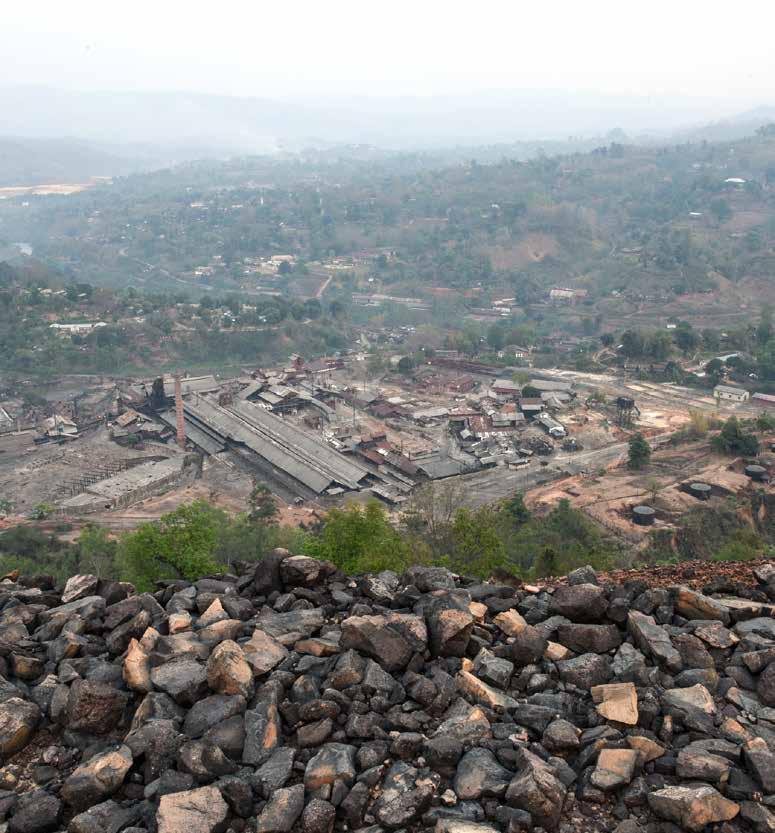


 By YAN PAI / NAMTU, SHAN STATE
By YAN PAI / NAMTU, SHAN STATE
Just before the rains set in, I set out on the 170-mile journey from Mandalay to Namtu in northern Shan State.
My destination: the legendary Bawdwin mine, developed under British rule by Herbert Hoover and others in the early part of the last century, before the former engineer and globetrotter became the 31st president of the United States.
The mine became famous before the Second World War as one of the globe’s biggest sources of lead as well as an important source of silver and zinc.

Today, the Bawdwin mine remains largely forgotten after it was nationalized in 1965 and handed over to the Asia World Company in 2010. I wondered what I would find.
In the early morning, the roads were dry and the only green I saw from the windows of my hired van were banyan trees, irrigated maze plantations and the uniforms of soldiers providing security on the road.
We passed through Pyin Oo Lwin, Gohtwin, Nawngkhio and Kyaukme before we arrived at around 10 am at the fork in the road in Hsipaw that leads to the near-deserted winding one-lane road to Namtu, 42 miles away.
Clockwise from top left: An old sign from 1914. Century-old mine buildings are starting to fall apart. A helpful sign provides information for railway buffs. Part of the scenic old railway track to the mine. An old steam engine.
The air was filled with the smell of smoke rising from land being burned off for farming. Occasionally I saw trees in full blossom, natural springs, grazing cattle and road workers on the four hour journey.
At Namtu, I discovered a town that is home to a diverse mix of people. There are many Bamar originally from the central dry zone, Chinese and Gurkhas as well as the local Shan, Kachin and Palaung.
In 1923-24 the Burma Corporation’s Bawdwin mine employed around 2,700 persons, up from around 2,000 persons the year before, according to a British government report of the period.

The mine produced a total output of 245,925 tons of lead and silver, up from 172,066 tons the previous year. It produced 4,843,939 ounces of refined silver.
There were 89 mining accidents throughout the whole of British Burma in 1923-24, including 20 deaths.

“The mines of the Burma Corporation in the Shan States were responsible for most of the accidents, including 16 deaths and 63 cases of serious injury.
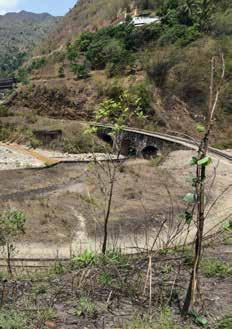
“The most serious accident was the fall of a cage full of coolies owing to the breaking of a clutch pin. There were no prosecutions under the [Mining] Act during the year,” said the report.
Source: Report on the Administration of Burma for the Year 1923-24 (British Government).
Scattered about the town and its environs on either side of the Namtu river (whose name translates as “rotten water” in the Shan language), I found relics of history in all directions.
On the western side of the river I found the old train station, with British-built warehouses still standing and a signboard that read, “1,765 feet above sea level.”
Steam locomotives with wooden coaches manufactured around the time of the First World War by UK firms Keer-Stuart & Co. Ltd and W.G. Bagnall Co. Ltd were stationed at the start of the spectacular winding railroad to Kya Sa Khan (“Tiger Camp”).
It was there that Herbert Hoover reportedly found the footprints of a tiger close to the source of what would become a massive mine descending 12 levels and 1,200 feet underground.

Once also called the Timber Mine for its walls propped up with local hardwood, today the Bawdwin depths are deserted and only accessible down to the sixth floor, according to engineer and foreman at the site U Tin Tun Aung.



Locals told me that an approximately 140-foot-long section of the railway line to “Tiger Camp” was damaged in last year’s rainy season and remains unrepaired.

Near the station, up a snaking hill road lined with eucalyptus and frangapani trees, I found a part of the old mine headquarters.
In the colonial period this rise was named Bo Gon (“foreigner hill”). The mine superintendent and foremen lived on the peak, where there was also a hospital and a post office.
On another hill close to the station is the deserted refinery that dates back more than 100 years. Here, I saw twofoot wide railway tracks, old coaches
and wheeled iron containers.
It was easy to imagine the bustle of the past, when thousands of workers led busy lives here. But now, silence reigns, and just a handful of male and female guards watch over the refinery on shifts.
A female guard showed me a room with a modern-looking Chinese-made iron furnace where silver, gold and lead were extracted.
Local sources later told me that state officials sold off five 30 foot high colonial-era furnaces before the mine was privatized. For a while back then, junior officials dug out a type of arsenic compound called “speiss” and sold it to Chinese buyers. “It was like a festival,” a local said, as money flowed through the area and gambling and drug abuse spread among local youth.

Nearby stands the chimney which channeled the fumes from the refinery into the open sky, and below this there is a high lava hill.
Though Bawdwin mine and the refinery have not functioned since privatisation five years ago, some open pit mining continues here and Asia World still has a skeleton staff, doing mainly odd jobs and security.
According to workers, the company is investing more in more profitable mines such as the Heinda mine and the Kawlin gold mine in Tanintharyi and Sagaing regions respectively.
But a Chinese-run refinery called “Myanmar Apex” is extracting zinc from the old lava dumps, effectively making money from rubbish.
Local workers say that badsmelling fumes and ash from the chimney may harm their health, but they have to put up with it as the refinery is a source of occasional work.
I had the sense that workers from various parts of Myanmar find it hard to leave this area where they recall the golden days and hope for a revival.
Some old-timers said they hoped a foreign investor might arrive with expertise as well as respect for labor conditions and the local environment.
They might get their wish. Though an expected new mining law is still delayed, there have been recent reports of Australian interest in Bawdwin area deposits.

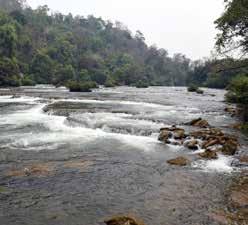
For me, if armed conflicts in the region cease, this place full of atmosphere and lovely scenery seems well-placed to become an attractive tourist draw.



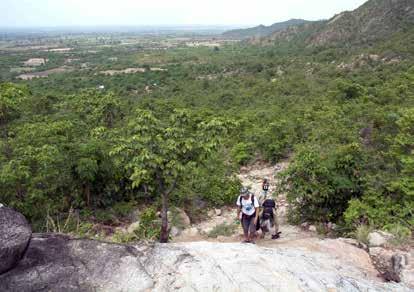
“BoeBoe Gyi, please help and guide us to find the prehistoric art,” said U Win Maung (Tamppawaddy), a veteran historian from Mandalay, as he made a ritual offering to the spirit of the mountain. “Since we are new to the region, bless us with safety.”

In front of him, various foods wrapped in green leaves were spread out on a stone slab. Candles were lit and about 25 people with bare feet knelt down behind him in the tiny village of A Htet Hlae Kan at the base of Pae Dwe mountain, between Shan State’s Ywa Ngan Township and Wun Dwin Township in Mandalay Region.
The group led by U Win Maung, including amateur historians, archaeologists, photographers, journalists and officials from the Ministry of Culture, was preparing for a journey to locate a series of prehistoric paintings found deep in the forest a few days earlier by an adventurous local.
After a few minutes of prayers, U Win Maung addressed one of his colleagues: “The ritual for the spirits is done. Be careful urinating in the forest as we go, do not face East or South.”
A local guide elaborated on this peculiar faux pas, telling the group that the mountain and forest spirits

don’t like people to face a sacred location when nature calls. He also warned against using bad language or wearing red clothes while walking through the forest.
“If we do so, we believe that we will be lost in the forest or attacked by wild [animals or spirits],” the guide said.
Shortly after setting out on a lateMay morning, the group decided to split into two, with some ascending the mountain by way of a dry and rocky waterway, while others took an alternative route across the Kin Tar dam.
Accompanied by The Irrawaddy, the latter group, which included Ko Win Bo—the local amateur adventurer who first discovered the paintings in a rock shelter in an area known locally as Mya Kha Nauk—crossed the Kin Tar dam at around midday on a motorized boat and hiked up the rocky mountain for the remainder of the afternoon.
It wasn’t until the following day that the exhausted trekkers reached Ywar Soe Pyin, a small village of only 15 households, and knew they were drawing closer.
Two and a half hours later, there it was: a rock shelter rising from the ground like the head of a giant anaconda.
Their spirits undimmed by the fact that the other group had reached the site before them, the excited team took no time to rest, but immediately produced cameras and tools and began to document and analyze what they saw.
The rock shelter, located on Pae Dwe mountain, is just eight miles southwest of the famous Padah-Lin
caves where numerous prehistoric paintings and tools were found 55 years ago.
On the ceiling of the shelter, partly stained by smoke from campfires in more recent times, fading reddish brown hand prints can be seen as well as animal figures resembling tortoises and deer and shapes resembling weapons.
The base of the rock shelter is covered with numerous names and dates, etched into the stone using
charcoal and chalk by contemporary villagers, hunters and woodcutters who frequented the area.
“We’ve seen these figures but we didn’t know what they were. Some of us used to rest here and make a fire to cook or to warm ourselves,” said U Maung Sann, a local woodcutter who served as a guide to the group.
“Some even wrote their names and the date to show they had been here. If we knew the value [of the site], we would not do this. Now we have to tell our friends not to write on this shelter.”
Opposite the rock shelter, on the smooth façade of a large boulder, the outline of an elephant is engraved, with the two lines that trace its figure filled in with red ochre. The elements have taken their toll on the depiction—about nine feet high and 14 feet wide—with some sections of its outline now absent.

In front of the large stone curtain, a rock slab is believed to have been used as a plinth for worship.
“People of prehistoric times used to worship huge animals like elephants as their gods,” U Win Maung explained. “Here, we found the plinth in front of the rock curtain, and it can be said that the area served as the altar where they came and worshipped for safe journeys during hunting and traveling.”
After a few minutes searching around the site, U Soe Aung, an amateur archaeologist from Sagaing, found some broken fragments of stone tools. The historians and archaeologists remarked that the tools were similar to those found in the Padah-Lin caves over five decades ago.
“[They] are from the Paleolithic era, and we can assume that the people who lived in Padah-Lin cave reached this area, hunted in this area, took shelter here and created an altar to worship,” said U Win Maung, possibly making the artifacts at least 10,000 years old.
Piles of stones and rocks leading away from the shelter form what is believed to have been a pathway marking the route to the site.

“In prehistoric times, people used to mark the route by piling up stones… From all of these findings, we can say that the paintings are from the same period as the paintings from Padah-Lin cave,” U Win Maung said.

“This is an important find for the archaeologists, which could prove that people were moving around in the Kaparni and Kyauk Sae valleys since prehistoric times. However, archaeologists here need technical assistance to date the paintings and to find out more about the region,” he added.
The Padah-Lin cave walls are also covered in prehistoric paintings which were discovered in 1960. Research and excavation of the caves was carried out the following year and archeologists discovered tools dating to the Paleolithic and Neolithic eras.
U Aung Aung Kyaw of the Ministry of Culture, who was part of the latest expedition to Pae Dwe mountain, said the ministry was planning to conserve the site and carry out research and excavation work.
“The elephant figure from the rock curtain alone is distinctly visible because its outlines are engraved. Most of the figures from the rock shelter are fading away due to weather and the smoke, requiring urgent care,” he said.
“We are planning to do excavation and research on the paintings very
soon and also need to educate the locals about protecting the heritage.”
Returning from the forest, the historians and archaeologists who took part in the expedition were already hatching plans to find out more about the site and what it may reveal about the country’s earlier inhabitants.
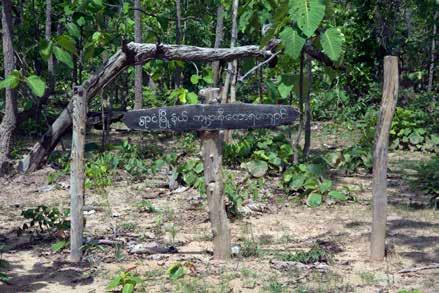
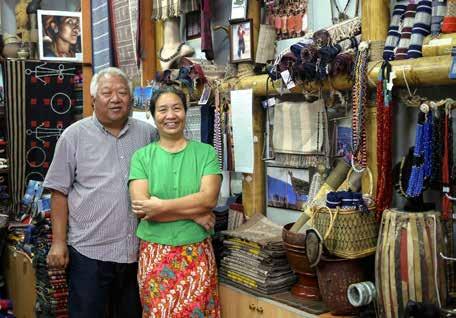 By SAN YAMIN AUNG / YANGON
By SAN YAMIN AUNG / YANGON

At a sideways glance, Yo Ya May seems less a textile shop than a museum. Sitting on the first floor of Yangon’s bustling Bogyoke Market, the store filled with Chin crafts and textiles is headed up by cofounders Khun Shwe and her husband Kyin Lam Mang and is an undeniable labor of love.


“My children tell me, ‘You are really absorbed in this job. Your soul will stay circling around the shop after you die,’” Khun Shwe told The Irrawaddy.
Founded in the 1990s, Yo Ya May has been based at the tourist hotspot since 2003, garnering praise from Lonely Planet and benefiting from the tourist boom of recent years.
Both 56-year-old Khun Shwe and her husband hail from Tedim Township in northern Chin State, and walking into their store is a window into their world. Sitting alongside hand-woven dresses and fabrics are photos of women in tribal dress and a library’s worth of books on ethnic weaving styles, techniques and fashions.
For the women behind Yo Ya May’s wares, there may be no worthier ambassadors than the store’s owners.
“We started this as a family business,” Khun Shwe said. “We continued with pride because with our work we are able to support Chin women as well.”
A mother of seven children, Khun Shwe said that most Chin women don’t get the chance to have a formal education, with many
villages in the remote mountainous state lacking even primary schools, and with most parents unwilling to send them away for their studies. In many of Chin State’s most isolated communities, the women instead devote all of their efforts to craft.
“They pour all of their creativity and imagination into their weaving; that becomes their masters degree,” she said.
When the business started, the stock came exclusively from the work of three elderly women from

the southern Chin State township of Paletwa. Each item was woven in keeping with the traditions of the Khami ethnic group, which according to Khun Shwe is the most complicated in design and technique of all local Chin styles.


As demand grew over the years, Yo Ya May has expanded to take work from members of the ethnic Chin community living in Sagaing Region and Rakhine State—some of whom are also trained in Naga craftsmanship—and have begun to stock the work of Kachin and Karen women. Around 100 women are now working for the store.
Cheery Zahau, a Chin women’s rights activist who will be contesting this year’s general election, told The Irrawaddy that Chin textiles are becoming more popular with higher tourist numbers, reinvigorating traditions that have until recent years been quarantined by the isolation of one of the country’s least developed communities.
“The larger the market is, the better for Chin women,” she said. “These women will have more income and they will be encouraged to preserve their culture.”
With a vast collection of vintage materials, Khun Shwe said she would like to open a museum in the future dedicated to promoting Chin culture.
With most of her trade dependent on foreign buyers, she believes that more should be done to foster a local appreciation of ethnic traditions.
“It is rare for local people to come to our shops,” she said. “Only foreigners buy souvenirs here. It would be better if more locals knew the true value of these products.”
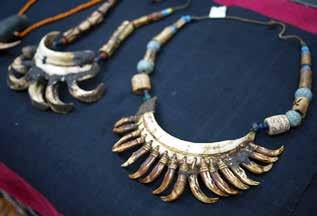

One long and frightening night in early May seven years ago, Dr. Tun Lwin was sitting in the darkness of his office as the wind howled outside. The storm he had forecast days before had knocked out the electricity, the internet and phone lines. It rained like doomsday.
Cyclone Nargis was approaching Yangon.
With the complete communication breakdown, the director-general cum consultant in Myanmar’s Department of Meteorology and Hydrology (DMH) was virtually cut off from the real-time situation on the ground.
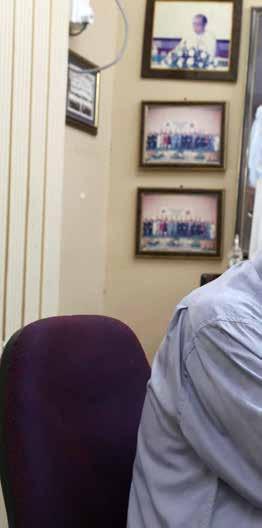
But the 60-year-old meteorologist, who had been following the storm since it first materialized as an atmospheric depression in the Bay of Bengal more than a week ago, couldn’t help making the mental calculations of its strength and predicted route by observing the growing speed and direction of the wind outside.
At around midnight, when the cyclone hit Myanmar’s commercial capital, a windowpane shattered behind him and the whole building trembled in the face of 128 mile per hour winds. He felt helpless; all he could do was say silent prayers.
“On that night until 5 am the next day, Nargis was like a bull elephant in musth, destroying everything [in its path],” Dr. Tun Lwin writes in his
memoir, “Nargis and I,” recalling the cyclone that devastated Myanmar’s Ayeyarwaddy delta and beyond, killing more than 130,000 people after making landfall on the night of May 2, 2008.
Published last month on the seventh anniversary of the cyclone, the book is the latest to document the country’s deadliest natural disaster.
Unlike other books on Nargis, the memoir objectively analyzes the factors that intensified the destruction wrought by the cyclone and is also a comprehensive personal account of how the DMH’s former director-general played a leading role in forecasting the storm and releasing warnings to the public.
In his foreword to the Myanmarlanguage book, Dr. Tun Lwin writes that readers should take lessons from the failures in response and preparation for Cyclone Nargis to prevent the recurrence of a tragedy on a similar scale.
“I have no intention to blame other people for their failure. We are all responsible for what we faced during Nargis… [But] as long as we don’t know the root cause of the problem and weaknesses, we will never get to the truth,” he writes.
In the memoir he explains that a huge death toll was inevitable despite his 48-hour early warning to local authorities and that people living in the delta, the area hit hardest by the cyclone, suffered in
lieu of effective emergency response and evacuation measures, citing a joint assessment report coauthored by DMH and the Asian Disaster Preparedness Center in Thailand.
“Even though people there received early storm and tidal surge warnings, they had no storm shelters to take refuge in or higher ground [to evacuate to] when the 22-foothigh tidal surge was generated by the storm. The area is densely populated and local people lacked experience as the delta had never been hit by a cyclone in 132 years,” he writes.
Myanmar since 1988. The country’s one, outdated weather surveillance radar had been out of order for years.
Dr. Tun Lwin had been able to receive satellite images of clouds from the ASEAN Specialized Meteorological Center in Singapore at 30 minute intervals via the internet. He tried to calculate the eye of the storm based on those images by using a ruler and a compass. He fed the data into his laptop every half hour to calculate the strength and direction of the storm.
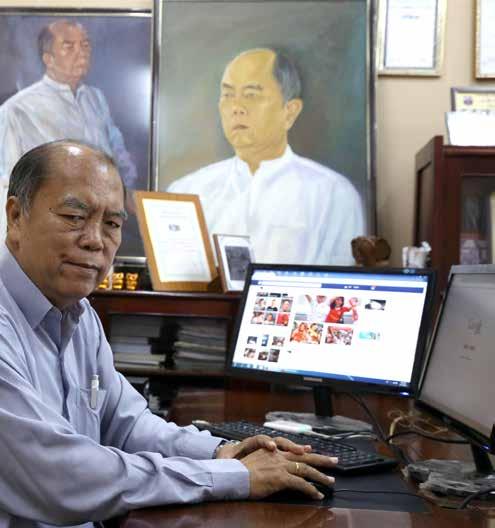
“Since late April, I spent my days and nights at the office to follow the storm. I rarely slept, apart from some naps,” he recalls in his book.
Dr. Tun Lwin and his team were recognized for their efforts by the World Meteorology Organization (WMO), which conducted an investigation into DMH one week after Nargis struck.
“Despite their capacity constraints, DMH performed exceedingly well… [The department] provided relevant authorities including mass media with information on Nargis from its formation in the Bay of Bengal and issued warnings well in advance,” the WMO said in its findings.
Asked why the book took seven years to see the light of day, the former department head told The Irrawaddy that he had only started writing about his Nargis experiences in the last year as “it’s a story of defeat about the storm that killed many people.”
“If the cyclone hit the Rakhine coastal region, I can guarantee that casualties will not be that high as people there generally have more experience with cyclones and strictly follow the warnings.”
Aside from the analytical insight into how Nargis turned out to be such a deadly disaster, Dr. Tun Lwin’s memoir also reveals his struggles in forecasting the storm.
Like other governmental departments, DMH lacked modern equipment, exacerbated by international sanctions imposed on
“It took me years as I felt sorry for the victims’ family members. The last thing I want for them is to reopen their old wounds,” said Dr. Tun Lwin, who is now the founder of Myanmar Climate Change Watch.
In recounting the devastating cyclone that he tracked and witnessed from beginning to end, Dr. Tun Lwin said he feels he has contributed to raising awareness about the need to adequately prepare for future natural disasters.
“Now I feel a big relief, like a woman who has just delivered her baby,” he said.
“Nargis was like a bull elephant in musth, destroying everything [in its path].”

 By CLAUDIA SOSA / YANGON
By CLAUDIA SOSA / YANGON
The story goes like this: Four people move to Yangon, and after a number of years, they become friends and commiserate over the dishes from home that they all miss. There is simply no good Russian food in Myanmar’s biggest city, so why not take matters into their own hands? None of them have any previous restaurant experience, but they’re all passionate about the idea; so much so that they even recruit a chef who travels from Russia to train the staff and man the kitchen. It sounds like the makings of a promising film, but is it the start of a great restaurant?
Tucked inside Yankin’s sleepy Yan Shin Street, Kvas restaurant has a pleasant, unassuming feel. Highbacked leather booths offer patrons an unexpected feeling of privacy, given the fact that the venue is small and that glass walls are all that separate indoor diners from those sitting on Kvas’ popular outdoor patio.
The harsh-sounding whispers and exclamations that emanate from the kitchen lend this place
a distinctly Russian feel; given its owners, that is not surprising.
“This is my life!” explains one of them, Zoriggo Gomboev. “Not only my life,” he adds, pointing to two of the co-owners who are enraptured in lively conversation involving plenty of gurgled Rs—“it’s their life.”
If chef Timu Bovayez’s life depended on serving his best dish, my guess is that he would serve customers one of the grilled items on the menu, likely the pork shashlik. The tender cuts of marinated pork are served on a bed of lettuce and tomato, and topped with pickled red onions. The pork is decidedly rich and satisfyingly salty, and the cuts are surrounded by generous bits of fat that add to the flavor, as well as to the heart attack potential of the dish. (If only we could walk it off by taking a stroll around the Kremlin in -8°C weather afterward.)
Not for the faint-hearted or sensitive of stomach—not to mention the lactose intolerant—the creamy, cheesy mushroom julienne was by far the most well-balanced appetizer of the night. The borscht, even if a bit heavy on the oil, subtly combined beets, carrots, tomatoes and pork
with the odd bit of sharp garlic or pickled onion. It set the stage for the chef’s love of tomatoes, which were in everything from the borscht to the pork shashlik, to sauce adorning a beef stroganoff that was oddly sweet and red in color.


It’s surprising that such rich food, designed to warm up the heart and insulate from the cold, could be so appetizing on Yangon’s hot and humid nights. It might be due to the fact that the chef is slowly adapting traditional Russian cooking to cater to local palates; heightening the


flavors so the salt is saltier, the spice spicier and so on.
Personally, I don’t believe the dishes need too much tweaking, and as long as the chef doesn’t change a thing about the beautifully glazed piroshky that are baked in-house to perfection, Kvas might just turn out to be one of those gambles where everyone—the chef, the diners, the owners—comes out winning.
Kvas: 202/8 Yan Shin Street, Yankin. Phone: 09-420076014

For Naw Eh Wah and her handmade jewelry shop, a kind of affirmative action dictates the hiring process.
“People with disabilities are like my relatives,” she says. “They are always in my heart. I am happier to give these jobs to them rather than giving jobs to others.”
After leaving her job as a livelihood coordinator for disabled people at a nongovernmental organization in 2013, Naw Eh Wah wanted to continue to better the lives of a community she had grown close to during four years working in Yangon’s Hlaing Tharyar Township.
For her, that meant continuing to do what she was good at: making handmade accessories, and in the process helping people with disabilities to earn a living.
So began “Amazing Grace,” a social enterprise that produces handmade jewelry and accessories from locally produced materials. The shop opened in February 2014 with the support of Naw Eh Wah’s family.
The Amazing Grace workforce is primarily comprised of people with disabilities. Most work from home and check in once a week to take assignments and deliver their creations to the shop. Their disabilities vary, from hearing impairment to polio to limited mobility resulting from accidents. What most also have in common is an ability to work well with their hands.
“I continue to teach them and learn new designs and find markets to sell the products,” the 27-year-old ethnic Karen woman says.
Making handmade accessories was not something new for Naw Eh Wah, for whom it had always been something of a hobby.
“I have been interested in making accessories since I was young,” she says. “I would always give my handmade products for friends’ birthdays.”
Amazing Grace’s products include earrings, bracelets and necklaces, all made from recycled materials such as bicycle tires, stones, beads and string.
Some items also come with a local flair, thanks in part to a Thai woman named Intira Thepsittawiwat.
Intira, who has a shared interest in handmade accessories, came to Naw Eh Wah in February with a proposal to produce necklaces using local fabric. Since then, the two women have been adding necklaces
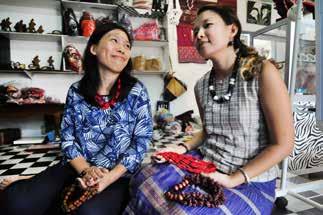
made from traditional longyi patterns and textiles to Amazing Grace’s repertoire.
“I want to make handmade jewelry made in Myanmar, so the materials should be something local,” Intira says. “I thought of longyis. I came here and I asked her, ‘Can you do that with a longyi?’”
The price for a piece of handmade jewelry ranges from 2,000 kyat (US$1.80) to 15,000 kyat, while handmade fabric necklaces can cost anywhere from 10,000 kyat to 30,000 kyat. The products are increasingly popular as wedding gifts, Naw Eh Wah says.
Amazing Grace currently employs about 10 people with disabilities. Each of them earn from 70,000 kyat to 100,000 kyat per month, based on the number of items they produce.
And business is good; Naw Eh Wah is looking to expand her roster of employees.
“Sometimes, our workforce is not enough to handle the workload,” she says.
Having grown up around people affected by leprosy at a hospital in Mon State’s Mawlamyine, Naw Eh Wah says her next step is to create jobs for them too. She has plans to teach men and women living around the hospital compound how to produce wooden blocks for kindergarten classrooms and handmade crafts.
“They have been affected by leprosy and are cured, but they are disabled in that they can’t go back to their environment,” she says, explaining that social stigma and physical impairments caused by leprosy make returning to society difficult.
“I will continue to find markets and expand my work,” she adds.


